Archive for the ‘Listening Post’ Category
Monday, October 24th, 2011
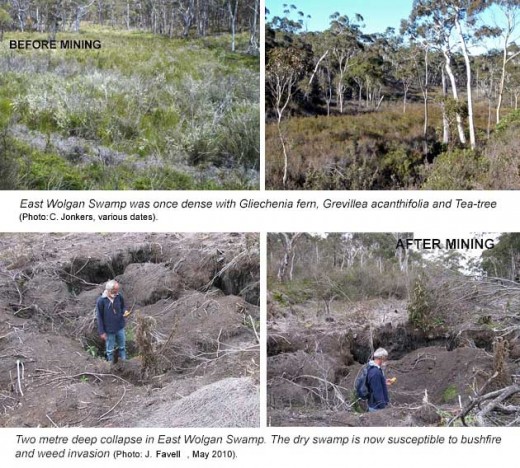
A New South Wales mining company has committed to pay $1.45 million after causing damage to a nationally threatened ecological community.
An investigation by the federal environment department found that the long wall coal mining operations of Centennial Coal on the Newnes Plateau, near Lithgow, New South Wales, had caused a significant impact on the endangered Temperate highland peat swamps on sandstone ecological community.
The mining activities caused a loss of ecosystem function shown by loss of peat, erosion, vegetation dieback and weed invasion in three swamps.
They also caused the formation of a large slump hole, several metres wide and more than one metre deep, at the East Wolgan Swamp.
These changes mean the swamps can no longer serve their important hydrological role of acting as water filters and releasing water slowly to downstream watercourses.
Centennial Coal will pay $1.45 million towards a research program to be administered by the Fenner School of Environment and Society at the Australian National University.
This research program will be of great conservation benefit for these protected swamps and inform better understanding of the impacts of land use change.
The program will map the distribution and extent of the swamps, explore their functions, water dynamics, ecology and history, and look at human impacts on the swamps. It will provide valuable knowledge to protect Temperate highland peat swamps on sandstone and to promote land management practices that minimise impacts on these swamps.
The payment will be made as an ‘enforceable undertaking’ under national environment law—the Environment Protection and Biodiversity Conservation Act 1999.
This is an effective way to hold companies accountable for environmental damage without going through lengthy and costly legal proceedings.
This outcome shows the Australian Government takes environmental protection seriously, and will not tolerate companies causing needless damage to the environment.
.
[Source: ‘Mining company to pay for environmental damage’, 20111021, by Justin McKee, ‘Gardens of Stone’ Campaigner, Blue Mountains Conservation Society]
.
Editor: If the New South Wales (NSW) Government agency responsible and accountable for environmental protection of threatened species cannot do its job and it takes the federal government agency to do its job for it , then the NSW agency is redundant and should be dissolved and responsibility handed to the federal government.
.
.
 Swamp on Newnes Plateau, Blue Mountains region
Swamp on Newnes Plateau, Blue Mountains region
.
‘Blue Mountains Swamps are a biologically diverse plant community that occurs nowhere else in the world. The vegetation in these swamps range from low buttongrass clumps to large shrubs such as Hakea and Grevillea species. The swamps provide essential habitat to several Threatened Species, such as the Blue Mountains Water Skink (Eulamprus leuraensis) and the Giant Dragonfly (Petalura gigantea).
.
Blue Mountains swamps play a vital part in maintaining the water flows in the areas creeks and waterfalls, by storing water and slowly releasing it over time. Swamps also act as filters, purifying water prior to the release into creeks. Other threatened species such as Epacris hamiltonii and Microstrobos fitzgeraldii rely on the continued seepage from hanging swamps for survival in their specialized habitats.
.
There are less than 3,000 ha of Blue Mountains Swamp in existence. As they predominantly comprise many small areas, they are very susceptible to edge effects.’.[Source: Blue Mountains Council, ^http://www.bmcc.nsw.gov.au/sustainableliving/environmentalinformation/livingcatchments/swampsandswampcare]
.
.
Swamps on Newnes Plateau provide critical habitat for the endangered Blue Mountains Water Skink

‘The Blue Mountains Water Skink (Eulamprus leuraensis) is a medium sized semi- aquatic lizard. It is one of Australia’s rarest lizards, and has only been found in 30 locations in the middle and upper Blue Mountains in New South Wales. Surveys suggest that the Blue Mountains Water Skink is restricted to an isolated, highly fragmented habitat of sedge and shrub swamps that occur between Newnes in the north and west and Hazelbrook in the south and east. Potential habitat to the south and northwest of known sites may extend the range of this species, however further survey work is required to determine whether the species utilises these areas.
The small number and apparent isolation of known populations, in conjunction with the limited geographic distribution of the Blue Mountains Water Skink make it vulnerable to the operation of threatening processes. Clearing for urban development and associated disturbance to habitat has resulted in the reduction of the area of known and potential habitat and the apparent extinction from areas where this species previously occurred. The small size of some swamps increases the risk of loss of one or more of the populations, and recolonisation of disjunct areas appears unlikely (LeBreton 1994c).
Possible threats include urban development (some locations are almost completely surrounded by houses and other locations have land zoned for further development adjacent to them), pollution and sedimentation (including stormwater run-off), alterations to hydrological regimes (through construction of roads, tracks, plantations and mining subsidence), weed invasion, visitor disturbance (trail bikes, 4WD) and predation by cats.
This recovery plan describes our current understanding of the Blue Mountains Water Skink and documents the research and management actions undertaken to date. The plan also identifies the parties responsible for the management actions required to ensure the ongoing viability of the species in the wild.
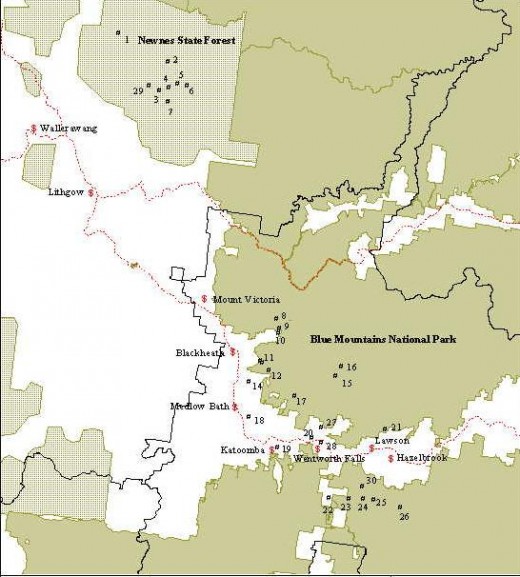 Known distribution of the Endangered Blue Mountains Water Skink Known distribution of the Endangered Blue Mountains Water Skink
.
‘The species has been listed as Endangered for the following reasons. It is an ecological specialist and is restricted to a highly fragmented montane swamp habitat. Many populations appear isolated and the small size of some swamps makes them vulnerable to ‘edge effects’ and increases the risk of loss of one or more populations through chance events. The ability of the Blue Mountains Water Skink to recolonise an area in the event of a local extinction may be low as a result of the discontinuity of the habitat and the apparently limited scope for dispersal (LeBreton 1996). These factors in conjunction with the limited geographic distribution of the Blue Mountains Water Skink make it particularly vulnerable to the operation of threatening processes.
A substantial number of known sites are located wholly or partially in national park (17 locations). The most significant threat facing these populations may be further urbanisation of adjacent areas as several of the sites occur in close proximity to residential areas or areas zoned for residential development. Other threats may include disturbance by visitors, invasion by weeds, inappropriate fire regimes and predation by cats.
Eight populations are recorded at Newnes Plateau on land managed by SFNSW. These populations may also face threats from weed invasion, inappropriate fire regimes and predation by cats. They could also face threats associated with timber harvesting activities and mining subsidence.’
.
[Source: The Recovery Plan for the Blue Mountains Water Skink (Eulamprus leuraensis), NSW National Parks and Wildlife Service, 200106, ISBN 0 7313 6283 7, ^http://www.environment.gov.au/biodiversity/threatened/publications/recovery/blue-mtns-water-skink/index.html]
.
.
Longwall Mining declared a ‘Key Threatening Process’ since 2005…hello!
.In 2005, the Scientific Committee, established by the Threatened Species Conservation Act, has made a Final Determination to list Alteration of habitat following subsidence due to longwall mining as a KEY THREATENING PROCESS in Schedule 3 of the Act. Listing of key threatening processes is provided for by Part 2 of the Act.The Scientific Committee has found that:
1. Longwall mining occurs in the Northern, Southern and Western Coalfields of NSW. The Northern Coalfields are centred on the Newcastle-Hunter region. The Southern Coalfield lies principally beneath the Woronora, Nepean and Georges River catchments approximately 80-120 km SSW of Sydney. Coalmines in the Western Coalfield occur along the western margin of the Sydney Basin. Virtually all coal mining in the Southern and Western Coalfields is underground mining.
2. Longwall mining involves removing a panel of coal by working a face of up to 300 m in width and up to two km long. Longwall panels are laid side by side with coal pillars, referred to as “chain pillars” separating the adjacent panels. Chain pillars generally vary in width from 20-50 m wide (Holla and Barclay 2000). The roof of the working face is temporarily held up by supports that are repositioned as the mine face advances (Karaman et al. 2001). The roof immediately above the coal seam then collapses into the void (also known as the goaf) and a collapse zone is formed above the extracted area. This zone is highly fractured and permeable and normally extends above the seam to a height of five times the extracted seam thickness (typical extracted seam thickness is approximately 2-3.5 m) (ACARP 2002). Above the collapse zone is a fractured zone where the permeability is increased to a lesser extent than in the collapse zone. The fractured zone extends to a height above the seam of approximately 20 times the seam thickness, though in weaker strata this can be as high as 30 times the seam thickness (ACARP 2002). Above this level, the surface strata will crack as a result of bending strains, with the cracks varying in size according to the level of strain, thickness of the overlying rock stratum and frequency of natural joints or planes of weakness in the strata (Holla and Barclay 2000).
3. The principal surface impact of underground coal mining is subsidence (lowering of the surface above areas that are mined) (Booth et al. 1998, Holla and Barclay 2000). The total subsidence of a surface point consists of two components, active and residual. Active subsidence, which forms 90 to 95% of the total subsidence in most cases, follows the advance of the working face and usually occurs immediately. Residual subsidence is time-dependent and is due to readjustment and compaction within the goaf (Holla and Barclay 2000). Trough-shaped subsidence profiles associated with longwall mining develop tilt between adjacent points that have subsided different amounts. Maximum ground tilts are developed above the edges of the area of extraction and may be cumulative if more than one seam is worked up to a common boundary. The surface area affected by ground movement is greater than the area worked in the seam (Bell et al. 2000). In the NSW Southern Coalfield, horizontal displacements can extend for more than one kilometre from mine workings (and in extreme cases in excess of three km) (ACARP 2002, 2003), although at these distances, the horizontal movements have little associated tilt or strain. Subsidence at a surface point is due not only to mining in the panel directly below the point, but also to mining in the adjacent panels. It is not uncommon for mining in each panel to take a year or so and therefore a point on the surface may continue to experience residual subsidence for several years (Holla and Barclay 2000).
4. The degree of subsidence resulting from a particular mining activity depends on a number of site specific factors. Factors that affect subsidence include the design of the mine, the thickness of the coal seam being extracted, the width of the chain pillars, the ratio of the depth of overburden to the longwall panel width and the nature of the overlying strata; sandstones are known to subside less than other substrates such as shales. Subsidence is also dependent on topography, being more evident in hilly terrain than in flat or gently undulating areas (Elsworth and Liu 1995, Holla 1997, Holla and Barclay 2000, ACARP 2001). The extent and width of surface cracking over and within the vicinity of the mined goaf will also decrease with an increased depth of mining (Elsworth and Liu 1995).
5. Longwall mining can accelerate the natural process of ‘valley bulging’ (ACARP 2001, 2002). This phenomenon is indicated by an irregular upward spike in an otherwise smooth subsidence profile, generally co-inciding with the base of the valley. The spike represents a reduced amount of subsidence, known as ‘upsidence’, in the base and sides of the valley and is generally coupled with the horizontal closure of the valley sides (ACARP 2001, 2002). In most cases, the upsidence effects extend outside the valley and include the immediate cliff lines and ground beyond them (ACARP 2002).
6. Mining subsidence is frequently associated with cracking of valley floors and creeklines and with subsequent effects on surface and groundwater hydrology (Booth et al. 1998, Holla and Barclay 2000, ACARP 2001, 2002, 2003). Subsidence-induced cracks occurring beneath a stream or other surface water body may result in the loss of water to near-surface groundwater flows. If the water body is located in an area where the coal seam is less than approximately 100-120 m below the surface, longwall mining can cause the water body to lose flow permanently. If the coal seam is deeper than approximately 150 m, the water loss may be temporary unless the area is affected by severe geological disturbances such as strong faulting. In the majority of cases, surface waters lost to the sub-surface re-emerge downstream. The ability of the water body to recover is dependent on the width of the crack, the surface gradient, the substrate composition and the presence of organic matter. An already-reduced flow rate due to drought conditions or an upstream dam or weir will increase the impact of water loss through cracking. The potential for closure of surface cracks is improved at sites with a low surface gradient although even temporary cracking, leading to loss of flow, may have long-term effects on ecological function in localised areas. The steeper the gradient, the more likely that any solids transported by water flow will be moved downstream allowing the void to remain open and the potential loss of flows to the subsurface to continue. A lack of thick alluvium in the streambed may also prolong stream dewatering (by at least 13 years, in one case study in West Virginia, Gill 2000). Impacts on the flows of ephemeral creeks are likely to be greater than those on permanent creeks (Holla and Barclay 2000). Cracking and subsequent water loss can result in permanent changes to riparian community structure and composition.
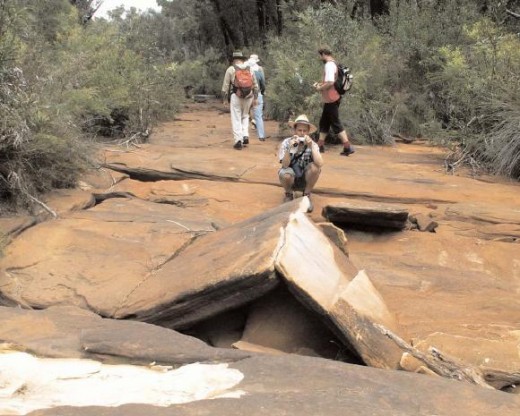 Longwall Mining Consequences
Total Environment Centre, ^http://www.tec.org.au/component/docman/doc_view/201-longwall-rep07 Longwall Mining Consequences
Total Environment Centre, ^http://www.tec.org.au/component/docman/doc_view/201-longwall-rep07
.
7. Subsidence can also cause decreased stability of slopes and escarpments, contamination of groundwater by acid drainage, increased sedimentation, bank instability and loss, creation or alteration of riffle and pool sequences, changes to flood behaviour, increased rates of erosion with associated turbidity impacts, and deterioration of water quality due to a reduction in dissolved oxygen and to increased salinity, iron oxides, manganese, and electrical conductivity (Booth et al. 1998, Booth and Bertsch 1999, Sidle et al. 2000, DLWC 2001, Gill 2000, Stout 2003). Displacement of flows may occur where water from mine workings is discharged at a point or seepage zone remote from the stream, and in some cases, into a completely different catchment. Where subsidence cracks allow surface water to mix with subsurface water, the resulting mixture may have altered chemical properties. The occurrence of iron precipitate and iron-oxidising bacteria is particularly evident in rivers where surface cracking has occurred. These bacteria commonly occur in Hawkesbury Sandstone areas, where seepage through the rock is often rich in iron compounds (Jones and Clark 1991) and are able to grow in water lacking dissolved oxygen. Where the bacteria grow as thick mats they reduce interstitial habitat, clog streams and reduce available food (DIPNR 2003). Loss of native plants and animals may occur directly via iron toxicity, or indirectly via smothering. Long-term studies in the United States indicate that reductions in diversity and abundance of aquatic invertebrates occur in streams in the vicinity of longwall mining and these effects may still be evident 12 years after mining (Stout 2003, 2004).8. The extraction of coal and the subsequent cracking of strata surrounding the goaf may liberate methane, carbon dioxide and other gases. Most of the gas is removed by the ventilation system of the mine but some gas remains within the goaf areas. Gases tend to diffuse upwards through any cracks occurring in the strata and be emitted from the surface (ACARP 2001). Gas emissions can result in localised plant death as anaerobic conditions are created within the soil (Everett et al. 1998).
9. Subsidence due to longwall mining can destabilise cliff-lines and increase the probability of localised rockfalls and cliff collapse (Holla and Barclay 2000, ACARP 2001, 2002). This has occurred in the Western Coalfield and in some areas of the Southern Coalfield (ACARP 2001). These rockfalls have generally occurred within months of the cliffline being undermined but in some cases up to 18 years after surface cracking first became visible following mining (ACARP 2001). Changes to cliff-line topography may result in an alteration to the environment of overhangs and blowouts. These changes may result in the loss of roosts for bats and nest sites for cliff-nesting birds.
10. Damage to some creek systems in the Hunter Valley has been associated with subsidence due to longwall mining. Affected creeks include Eui Creek, Wambo Creek, Bowmans Creek, Fishery Creek and Black Creek (Dept of Sustainable Natural Resources 2003, in lit.). Damage has occurred as a result of loss of stability, with consequent release of sediment into the downstream environment, loss of stream flow, death of fringing vegetation, and release of iron rich and occasionally highly acidic leachate. In the Southern Coalfields substantial surface cracking has occurred in watercourses within the Upper Nepean, Avon, Cordeaux, Cataract, Bargo, Georges and Woronora catchments, including Flying Fox Creek, Wongawilli Creek, Native Dog Creek and Waratah Rivulet. The usual sequence of events has been subsidence-induced cracking within the streambed, followed by significant dewatering of permanent pools and in some cases complete absence of surface flow.
11. The most widely publicised subsidence event in the Southern Coalfields was the cracking of the Cataract riverbed downstream of the Broughtons Pass Weir to the confluence of the Nepean River. Mining in the vicinity began in 1988 with five longwall panels having faces of 110 m that were widened in 1992 to 155 m. In 1994, the river downstream of the longwall mining operations dried up (ACARP 2001, 2002). Water that re-emerged downstream was notably deoxygenated and heavily contaminated with iron deposits; no aquatic life was found in these areas (Everett et al. 1998). In 1998, a Mining Wardens Court Hearing concluded that 80% of the drying of the Cataract River was due to longwall mining operations, with the balance attributed to reduced flows regulated by Sydney Water. Reduction of the surface river flow was accompanied by release of gas, fish kills, iron bacteria mats, and deterioration of water quality and instream habitat. Periodic drying of the river has continued, with cessation of flow recorded on over 20 occasions between June 1999 and October 2002 (DIPNR 2003). At one site, the ‘Bubble Pool”, localised water loss up to 4 ML/day has been recorded (DIPNR 2003). Piezometers indicated that there was an unusually high permeability in the sandstone, indicating widespread bedrock fracturing (DIPNR 2003). High gas emissions within and around areas of dead vegetation on the banks of the river have been observed and it is likely that this dieback is related to the generation of anoxic conditions in the soil as the migrating gas is oxidised (Everett et al. 1998). An attempt to rectify the cracking by grouting of the most severe crack in 1999 was only partially successful (AWT 2000). In 2001, water in the Cataract River was still highly coloured, flammable gas was still being released and flow losses of about 50% (3-3.5 ML/day) still occurring (DLWC 2001). Environmental flow releases of 1.75 ML/day in the Cataract River released from Broughtons Pass Weir were not considered enough to keep the river flowing or to maintain acceptable water quality (DIPNR 2003).
12. Subsidence associated with longwall mining has contributed to adverse effects (see below) on upland swamps. These effects have been examined in most detail on the Woronora Plateau (e.g. Young 1982, Gibbins 2003, Sydney Catchment Authority, in lit.), although functionally similar swamps exist in the Blue Mountains and on Newnes Plateau and are likely to be affected by the same processes. These swamps occur in the headwaters of the Woronora River and O’Hares Creek, both major tributaries of the Georges River, as well as major tributaries of the Nepean River, including the Cataract and Cordeaux Rivers. The swamps are exceptionally species rich with up to 70 plant species in 15 m2 (Keith and Myerscough 1993) and are habitats of particular conservation significance for their biota. The swamps occur on sandstone in valleys with slopes usually less than ten degrees in areas of shallow, impervious substrate formed by either the bedrock or clay horizons (Young and Young 1988). The low gradient, low discharge streams cannot effectively flush sediment so they lack continuous open channels and water is held in a perched water table. The swamps act as water filters, releasing water slowly to downstream creek systems thus acting to regulate water quality and flows from the upper catchment areas (Young and Young 1988).
13. Upland swamps on the Woronora Plateau are characterised by ti-tree thicket, cyperoid heath, sedgeland, restioid heath and Banksia thicket with the primary floristic variation being related to soil moisture and fertility (Young 1986, Keith and Myerscough 1993). Related swamp systems occur in the upper Blue Mountains including the Blue Mountains Sedge Swamps (also known as hanging swamps) which occur on steep valley sides below an outcropping claystone substratum and the Newnes Plateau Shrub Swamps and Coxs River Swamps which are also hydrologically dependent on the continuance of specific topographic and geological conditions (Keith and Benson 1988, Benson and Keith 1990). The swamps are subject to recurring drying and wetting, fires, erosion and partial flushing of the sediments (Young 1982, Keith 1991). The conversion of perched water table flows into subsurface flows through voids, as a result of mining-induced subsidence may significantly affect the water balance of upland swamps (eg Young and Wray 2000). The scale of this impact is currently unknown, however, changes in vegetation may not occur immediately. Over time, areas of altered hydrological regime may experience a modification to the vegetation community present, with species being favoured that prefer the new conditions. The timeframe of these changes is likely to be long-term. While subsidence may be detected and monitored within months of a mining operation, displacement of susceptible species by those suited to altered conditions is likely to extend over years to decades as the vegetation equilibrates to the new hydrological regime (Keith 1991, NPWS 2001). These impacts will be exacerbated in periods of low flow. Mine subsidence may be followed by severe and rapid erosion where warping of the swamp surface results in altered flows and surface cracking creates nick-points (Young 1982). Fire regimes may also be altered, as dried peaty soils become oxidised and potentially flammable (Sydney Catchment Authority, in lit.) (Kodela et al. 2001).
14. The upland swamps of the Woronora Plateau and the hanging swamps of the Blue Mountains provide habitat for a range of fauna including birds, reptiles and frogs. Reliance of fauna on the swamps increases during low rainfall periods. A range of threatened fauna including the Blue Mountains Water Skink, Eulamprus leuraensis, the Giant Dragonfly, Petalura gigantea, the Giant Burrowing Frog, Heleioporus australiacus, the Red-crowned Toadlet, Pseudophryne australis, the Stuttering Frog Mixophyes balbus and Littlejohn’s Tree Frog, Litoria littlejohni, are known to use the swamps as habitat. Of these species, the frogs are likely to suffer the greatest impacts as a result of hydrological change in the swamps because of their reliance on the water within these areas either as foraging or breeding habitat. Plant species such as Persoonia acerosa, Pultenaea glabra, P. aristata and Acacia baueri ssp. aspera are often recorded in close proximity to the swamps. Cliffline species such as Epacris hamiltonii and Apatophyllum constablei that rely on surface or subsurface water may also be affected by hydrological impacts on upland swamps, as well as accelerated cliff collapse associated with longwall mining.
15. Flora and fauna may also be affected by activities associated with longwall mining in addition to the direct impacts of subsidence. These activities include clearing of native vegetation and removal of bush rock for surface facilities such as roads and coal wash emplacement and discharge of mine water into swamps and streams. Weed invasion, erosion and siltation may occur following vegetation clearing or enrichment by mine water. Clearing of native vegetation, Bushrock removal, Invasion of native plant communities by exotic perennial grasses and Alteration to the natural flow regimes of rivers and streams and their floodplains and wetlands are listed as Key Threatening Processes under the Threatened Species Conservation Act (1995).
The following threatened species and ecological communities are known to occur in areas affected by subsidence due to longwall mining and their habitats are likely to be altered by subsidence and mining-associated activities:
.
Endangered Species
-
Epacris hamiltonii a shrub
-
Eulamprus leuraensis Blue Mountains Water Skink
-
Hoplocephalus bungaroides Broad-headed Snake
-
Isoodon obesulus Southern Brown Bandicoot
-
Petalura gigantea Giant Dragonfly
.
Vulnerable species
- Acacia baueri subsp. aspera
- Apatophyllum constablei
- Boronia deanei
- Cercartetus nanus Eastern Pygmy Possum
- Epacris purpurascens var. purpurascens
- Grevillea longifolia
- Heleioporus australiacus Giant Burrowing Frog
- Ixobrychus flavicollis Black Bittern
- Leucopogon exolasius
- Litoria littlejohni Littlejohn’s Tree Frog
- Melaleuca deanei
- Mixophyes balbus Stuttering Frog
- Myotis adversus Large-footed Myotis
- Persoonia acerosa
- Potorous tridactylus Long-nosed Potoroo
- Pseudophryne australis Red-crowned Toadlet
- Pteropus poliocephalus Grey-headed Flying Fox
- Pterostylis pulchella
- Pultenaea aristata
- Pultenaea glabra
- Tetratheca juncea
- Varanus rosenbergi Rosenberg’s Goanna
.
Endangered Ecological Communities
- Genowlan Point Allocasuarina nana Heathland
- Newnes Plateau Shrub Swamp in the Sydney Basin Bioregion
- O’Hares Creek Shale Forest
- Shale/Sandstone Transition Forest
.
Species and populations of species not currently listed as threatened but that may become so as a result of habitat alteration following subsidence due to longwall mining include:
- Acacia ptychoclada
- Almaleea incurvata
- Darwinia grandiflora
- Dillwynia stipulifera
- Epacris coricea
- Grevillea acanthifolia subsp. acanthifolia
- Hydromys chrysogaster Water rat
- Lomandra fluviatilis
- Olearia quercifolia
- Pseudanthus pimelioides
.
16. Mitigation measures to repair cracking creek beds have had only limited success and are still considered experimental (ACARP 2002). Cracks less than 10 mm wide may eventually reseal without active intervention provided there is a clay fraction in the soil and at least some water flow is maintained. Cracks 10-50 mm wide may be sealed with a grouting compound or bentonite. Cracks wider than 50 mm require concrete (ACARP 2002). Pattern grouting in the vicinity of Marhnyes Hole in the Georges River has been successful at restoring surface flows and reducing pool drainage following fracturing of the riverbed (International Environmental Consultants 2004). Grouting of cracks also appears to have been relatively effective in Wambo Creek in the Hunter Valley. Installation of a grout curtain in the Cataract River, however, has been only partially successful and it was concluded in 2002, after rehabilitation measures had taken place, that the environment flows released from Broughtons Pass Weir by the Sydney Catchment Authority were insufficient to keep the Cataract River flowing or to maintain acceptable water quality (DIPNR 2003). Mitigation measures themselves may have additional environmental impacts due to disturbance from access tracks, the siting of drilling rigs, removal of riparian vegetation, and unintended release of the grouting material into the water. Furthermore, even measures that are successful in terms of restoring flows involve temporary rerouting of surface flows while mitigation is carried out (generally for 2-3 weeks at each grouting site). Planning for remediation measures may also be hampered by the lack of predictability of some impacts, and difficulties gaining access to remote areas where remedial works are needed. The long-term success of mitigation measures such as grouting is not yet known. It is possible that any ongoing subsidence after grouting may reopen cracks or create new ones. Further, it is not yet known whether the clay substance bentonite, which is often added to the cement in the grouting mix, is sufficiently stable to prevent shrinkage. Grouting under upland and hanging swamps that have no definite channel is probably not feasible.17. Empirical methods have been developed from large data sets to predict conventional subsidence effects (ACARP 2001, 2002, 2003). In general, these models have proved more accurate when predicting the potential degree of subsidence in flat or gently undulating terrain than in steep topography (ACARP 2003). A major issue identified in the ACARP (2001, 2002) reports was the lack of knowledge about horizontal stresses in geological strata, particularly those associated with river valleys. These horizontal stresses appear to play a major role in the magnitude and extent of surface subsidence impacts. The cumulative impacts of multiple panels also appear to have been poorly monitored. The general trend in the mining industry in recent years toward increased panel widths (from 200 up to 300 m), which allows greater economies in the overall costs of extraction, means that future impacts will tend to be greater than those in the past (ACARP 2001, 2002).18. In view of the above the Scientific Committee is of the opinion that Alteration of habitat following subsidence due to longwall mining adversely affects two or more threatened species, populations or ecological communities, or could cause species, populations or ecological communities that are not threatened to become threatened.’
.
by Dr Lesley Hughes, Chairperson, Scientific Committee, Proposed Gazettal date: 15/07/05
[Source: ^http://www.environment.nsw.gov.au/determinations/LongwallMiningKtp.htm]
.
.
Further Reading:
.
[1] Colong Foundation for Wilderness Ltd ^http://www.colongwilderness.org.au/Gardens_of_Stone/GoS2_Swamp_monitoring.htm
.
[2] ‘NPWS confirms long wall mining is a key threatening process‘, ^http://archive.lee.greens.org.au/index.php/content/view/1345/65/
.
[3] ‘Impacts of Longwall Coal Mining on the Environment in New South Wales‘ report, Total Environment Centre ^http://www.tec.org.au/component/docman/doc_view/201-longwall-rep07 [Read Report]
.
[4] The BushDoctor Pty Ltd, ^http://www.bushdoctor.com.au/experience_blueMountains.htm
.
[5] The Scientific Committee of NSW, Determination on Longwall Mining, 20050715, ^http://www.environment.nsw.gov.au/determinations/LongwallMiningKtp.htm]
.
[6] ‘Blue Mountains Water Skink Recovery Plan‘, National Parks and Wildlife Service 2001, [Read Plan]
.
Tags: Blue Mountains, Blue Mountains Conservation Society, Blue Mountains Sedge Swamps, Blue Mountains Water Skink, Centennial Coal, Colong Foundation for Wilderness, East Wolgan Swamp, enforceable undertaking, Environment Protection and Biodiversity Conservation Act 1999, Epacris hamiltonii, Fenner School of Environment and Society, Giant Dragonfly, hanging swamps, long wall coal mining, loss of ecosystem function, Microstrobos fitzgeraldii, Newnes Plateau, Subsidence due to longwall mining, threatened ecological community
Posted in Blue Mountains (AU), Threats from Mining | No Comments »
Add this post to Del.icio.us - Digg
Sunday, October 23rd, 2011
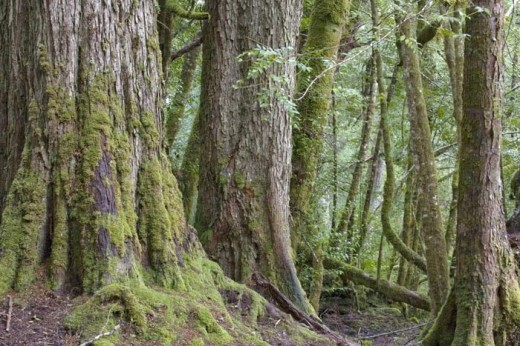 It starts with a natural forest that due to ‘humanity’ has become rare, threatened and endangered It starts with a natural forest that due to ‘humanity’ has become rare, threatened and endangered
~ Tasmania’s ancient wild Weld Forest
.
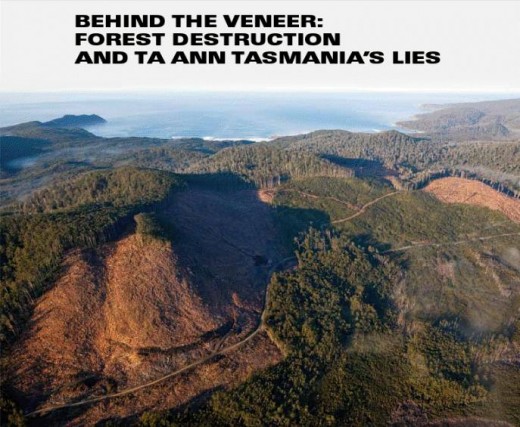 Tasmanian Old Growth Eucalypt Forests destroyed by Forestry Tasmania and onsold to Ta Ann
http://www.huon.org/
Tasmanian Old Growth Eucalypt Forests destroyed by Forestry Tasmania and onsold to Ta Ann
http://www.huon.org/
.
Malaysian industrial logger ‘Ta Ann Tasmania‘ (Ta Ann) has overtaken the monolithic Gunns Ltd as the biggest baddest logger of Tasmanian native Eucalypt forests and is busy enticing new overseas markets to flog Tasmanian Eucalypt timber.
Ta Ann claims that it exports rotary peeled veneer manufactured only from regrowth and plantation Eucalypt logs supplied by Forestry Tasmania, boasting its logging operations and timber products as environmentally sustainable.
But the reality is that Ta Ann is sourcing timber from Tasmanian old growth forests, from world heritage value and high conservation value forests.
As many Tasmanians are well familiar, Tasmanian Government impune Forestry Tasmania has an internal cultural penchant do anything to log and flog Tasmanian forests to perpetuate its own survival. Tasmanian legislation allows it to log, slaughter and rule with impunity like a forestry Mugabi, Gaddafi or Pol Pot. Forestry Tasmania is accountable only unto itself.

In 2008, AusIndustry even awarded Ta Ann winner of the Emerging Exporter Award for building its new flooring ply market in Japan flogging Tasmanian Eucalypt forest timber, all on the presumption that Ta Ann’s chain-of-custody certification was assured and legitimate. But was it and is it?
Tasmania’s big business biased history has shown that the promise of lots of local jobs by alluring big business causes dizzy evangelism by naive high school politicians, which then abandon ethics and Tasmanian community pride for the promise of the big buck. Traditional Tasmanian timber asset and its passionate local craftsmanship have been repeatedly betrayed by short-termism party politicians to cheap asian woodchipping mentality.
The latest Tas-rapist is ‘Ta Ann’ owned by exploitative unscrupulous Malaysian logger mogul Abdul Hamed Sepawi. He treats Sarawak indigenous locals like scum, so why would he feel any different to Tasmanians? – be it old growth forests, timber workers, their families, Tasmania’s economy or rural society?
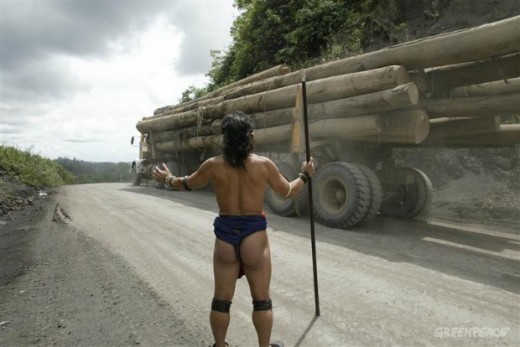 Indigenous Sarawak of Borneo seeing their forests go to Abdul’s Malaysian industrial loggers Indigenous Sarawak of Borneo seeing their forests go to Abdul’s Malaysian industrial loggers
.
Abdul is into logging Tasmanian forests for his own empire. Those Tasmanians participating in Ta Ann operations are not only feeding an asian mogul’s personal wealth, they are selling Tasmania’s unique forest assets, accepting pittance pay, and watching the asian mogul smile.
 Malaysian’s Logger Mogul… Greedy Abdul Malaysian’s Logger Mogul… Greedy Abdul
.
One day Tasmanians working in forestry will acknowledge that the radial feral greenies are not their adversaries but indeed more Tasmanian patriotic than their asian logging employers and Tasmanian Labor’s soul-selling politicians.
It is time Tasmania’s skilled woodcraftsmen had their say over the unethical, self-perpetuating and uncontrolled smiling eco-rapists of Forestry Tasmania and its exploitative asian logging moguls.
 Smiles of the asian woodchipper and Tasmanian soul seller Smiles of the asian woodchipper and Tasmanian soul seller
.
Based on the claim of ‘forestry certification’ legitimacy, Ta Ann has been locally encourage to build its second timber mill at rural Smithton in north-west Tasmania to supply emerging flooring ply/veneer markets in Malaysia, Japan and China.
.
[Source: ^ http://www.exportawards.gov.au/Resources/Case-Studies/Ta-Ann-Tasmania/default.aspx]
.
.
However, Tasmania’s forest campaigners Jenny Weber and Peg Putt have exposed Ta Ann Tasmania’s timber source to some of their customers in Japan, in alliance with Japanese forest campaign organisation JATAN. Meetings have been held with flooring manufacturer Panasonic Electric Works and Japan’s largest house building companies, Sekisui House and Daiwa House.

Huon Valley Environment Centre’s Jenny Weber with International Forests and Climate campaigner and former leader of the Tasmanian Greens Peg Putt, also met with Japanese and international NGO’s who are focused on forest protection, whilst visiting Japan. A media conference was held in Tokyo.
‘Huon Valley Environment Centre released a report in October that exposes Ta Ann has sourced timber in Tasmania from world heritage value, old growth and high conservation value forests. Ta Ann and their Japanese partner claim that their timber from Tasmania is only sourced from plantations and regrowth forests. Our message to the customers of Ta Ann was that the source of the company’s timber has been misrepresented,’ Huon Valley Environment Centre’s Jenny Weber said.
Companies such as Panasonic Electric Works, Sekisui House and Daiwa House have set goals to procure environmentally friendly timber, whose production does not contribute to large scale logging, nor harm biodiversity or the climate.
.
‘Informing these companies about the ecologically destructive logging practices in Tasmania and the reality that Ta Ann is sourcing timber from old growth, world heritage value and high conservation value forests was a shock to the companies who believe the timber source is environmentally friendly, who had been misled and in some cases thought that Ta Ann’s veneer was plantation grown,’ Jenny Weber said.
‘Even worse Ta Ann is standing in the way of full protection of 572,000 hectares identified for reservation in the Intergovernmental Agreement on Tasmania’s forests, and this company is implicated in environmental and human rights abuses in Sarawak. It was important to inform Japanese customers of the potential reputational damage involved in their relationship with Ta Ann,’ Peg Putt said.
‘Ta Ann in Tasmania is now going to be a focus of our campaign, following our successful collaboration with Australia NGO’s over the woodchip trade between Tasmania and Japan. I have visited forests in Tasmania that have been logged for Ta Ann in Tasmania, and witnessed the forest destruction on many occasions,’ said Akira Harada of JATAN.
.
[Source: ‘Tasmania’s forest campaign goes global – Ta Ann Exposed to Customers in Japan, 20111015, Huon Valley Environment Centre, Tasmania]
.
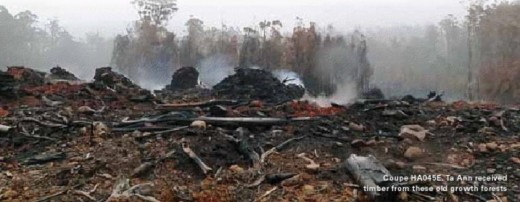 Forestry Tasmania Coupe HA045E was Eucalypt old growth
Ta Ann received timber from this coupe, which therefore annuls its ‘Sustainable Timber’ Certification Forestry Tasmania Coupe HA045E was Eucalypt old growth
Ta Ann received timber from this coupe, which therefore annuls its ‘Sustainable Timber’ Certification
.
Read the Huon Valley Environment Centre’s 2011 Report: ^http://bit.ly/mRlUbs
.
.
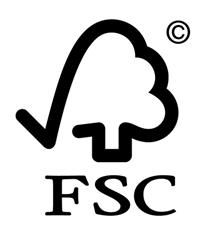
The Huon Valley Environment Centre’s 2011 Report needs to be investigated by the Forestry Stewardship Council (FSC) Australia with the support of the Australian Government, because the report calls into question the credibility of Australia’s timber exports having a certification chain-of-custody. If the Huon Valley Environment Centre’s report is true, and there is no doubt that it isn’t, then Ta Ann’s business model is relying upon a fraud, meaning its entire market risks unraveling, along with the 120 or so Tasmanian timber jobs it supposedly supports.
FSC certification and labeling is supposed to guarantee to end consumers that such timber products and materials have been harvested, processed and manufactured in a sustainable fashion – complying with sound forest management standards and principals. The FSC label is the gold standard in forest management and sustainable wood products.
FSC products are denoted by the FSC label. The right to use this label on a product means that a company must comply with all of the FSC requirements for management and operations. The requirements set forth by the FSC are based on 10 principles and 56 criteria.
.
The principles that guide FSC certification are as follows:
.
Principle 1. Compliance with all applicable laws and international treaties
Principle 2. Demonstrated and uncontested, clearly defined, long–term land tenure and use rights
Principle 3. Recognition and respect of indigenous peoples’ rights
Principle 4. Maintenance or enhancement of long-term social and economic well-being of forest workers and local communities and respect of worker’s rights in compliance with International Labour Organisation (ILO) conventions
Principle 5. Equitable use and sharing of benefits derived from the forest
Principle 6. Reduction of environmental impact of logging activities and maintenance of the ecological functions and integrity of the forest
Principle 7. Appropriate and continuously updated management plan
Principle 8. Appropriate monitoring and assessment activities to assess the condition of the forest, management activities and their social and environmental impacts
Principle 9. Maintenance of High Conservation Value Forests (HCVFs) defined as environmental and social values that are considered to be of outstanding significance or critical importance
Principle 10. In addition to compliance with all of the above, plantations must contribute to reduce the pressures on and promote the restoration and conservation of natural forests.
.
FSC Chain of Custody Certification
Chain of custody (CoC) certification allows manufacturers who process and trade in timber and other non-timber forest materials to trace and account for the FSC certified wood in their products. Companies with FSC CoC certification can label products with the FSC label if they comply with the standards.
.
[Source: ^http://www.green3dhome.com/GoGreen/FSCCertificationandLabeling.aspx]
 Gardening guru Peter Cundall prepared to be arrested for Tasmanian Principle
to defend Tasmania’s Forests and Tasmania’s democracy protesting against a pulp mill.
(19 Nov 2009)
Gardening guru Peter Cundall prepared to be arrested for Tasmanian Principle
to defend Tasmania’s Forests and Tasmania’s democracy protesting against a pulp mill.
(19 Nov 2009)
.
Watch on You Tube: http://www.youtube.com/watch?v=OVRhUtJBjxc
.
.
If the Huon Valley Environment Centre’s report is true then it would mean that Forestry Tasmania is complicit in Sustainable Timber Certification fraud and it would make Australia’s Emerging Exporter Award a joke.
Australia’s Emerging Exporter Award is a national Australian programme jointly run by The Australian Trade Commission (Austrade) and the Australian Chamber of Commerce and Industry (ACCI), which recognises and honours exporters who have achieved sustainable export growth through innovation and commitment. It celebrates and highlights the valuable contribution that exporters make to Australia’s economy, and encourages other companies to engage in international business. The programme objectives even states that it is to ‘promote Australia’s leading exporters to the same status and public recognition as sporting and entertainment heroes’. So Ta Ann is up there with Donald Bradman?
But Ta Ann Tasmania is a Malaysian multinational corporation and all profit go to overseas to its Malaysian logging mogul, Abdul Hamed Sepawi. Ta Ann, has not only been destroying rainforests in Sarawak but has been invited to pillage Tasmanian old growth Eucalypt forests by yours truly, Forestry Tasmania. So how can this venture be beneficial for Australia except for the so-called ‘export revenue’ making government export performance look good on paper?
.
‘Ta Ann is the biggest hardwood timber company in the world in terms of market capitalization. It has been able to achieve this through its close ties with the corrupt Chief Minister of Sarawak, Abdul Taib, whose vast wealth and power has been amassed through the strategic distribution of timber concessions. Taib is also finance minister and planning and resource management minister.
Earlier this month (March 2011) , the European NGO “Bruno Manser Fonds” (founded by the Swiss activist of Bruno Manser who lived in the jungle with the Penan from 1984 to 1990 and shared their struggle before mysteriously disappearing in Sarawak in 2000) released a blacklist of 49 companies in 8 countries (10 of them based in Australia) and is urging anti-corruption and anti-money laundering authorities in these countries to investigate any improprieties.
This is being reported in the Malaysian press as follows: “According to Malaysia’s Democratic Action Party (DAP), Taib has failed to account for a staggering 4.8 billion Malaysian ringgits (1.58 billion US dollars) of Sarawak state funds over the past three years alone. In 2007, the Tokyo tax authorities uncovered a massive corruption scheme that involved the payment of kickbacks to the Taib family. In return, nine Japanese shipping companies had received export licences to carry logs to Japan, Sarawak’s largest timber export market.” . And so on.
Ta Ann Holding’s chairman is Taib’s cousin, Abdul Hamed Sepawi. In 2008, Forbes listed Sepawi as the 30th richest man in Malaysia. Ta Ann holds 408,366 hectares of timber concessions, including the Raplex and Pasin timber concessions, which were previously controlled by Taib. They are also heavily engaged in the establishment of industrial tree plantations and oil palm plantations on Native Customary Land In Malaysia.
As Tasmania’s main newspaper, The Mercury reported on Sat Nov 8 2008 p11: “Ta Ann was lured to Tasmania by the cheap timber price offered by Forestry Tasmania. Ta Ann chairman Datuk Hamed Sepawi told Tasmanian media in 2006 that hardwood from this state was cheaper than wood from Malaysian and Indonesian forests…. Ta Ann’s deal with the State Government locked in the price it would pay for the timber at the 2006 level for the next 15 years.”
Ta Ann has a wood supply contract for 265,000 m3 a year. It is estimated that Ta Ann is paying approximately US$50 per cubic meter for these logs at a fixed price and then selling the product for US$387 per cubic meter.’
.
[Source: The Southern Forests Convergence: Conservation in Tasmania’ by John Seed, <Living Green Magazine, ^http://www.livinggreenmag.com/archives/climate_nature/southern_forests.html]
.
.
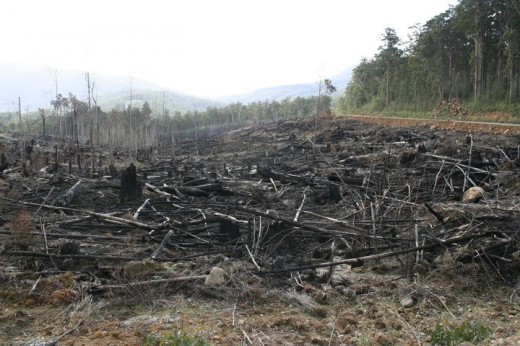
The Huon Valley Environment Centre and Still Wild Still Threatened are Tasmanian grassroots conservation organisations committed to ending logging in Tasmania’s old-growth forests.
.
“Our organisations are committed to continuing the campaign to call for the immediate protection of all native forests in Tasmania, including a moratorium on the globally significant high-conservation-value forests and a swift transition out of native forest logging in Tasmania.” ~ Jenny Weber
.
Three protests were held around Hobart yesterday (26th March 2011) as part of the 10-day vigil by the Huon Valley Environment Centre and Still Wild Still Threatened groups to stop logging in old-growth forests.
Four protesters were arrested outside the Ta Ann Hobart office yesterday morning during a sit-in demonstration against Ta Ann’s alleged illegal activity in Sarawak.
.
[Source: ‘Police anger over protest‘, by Brian Ward, Hobart Mercury, 20110326, ^http://www.themercury.com.au/article/2011/03/26/217591_tasmania-news.html]
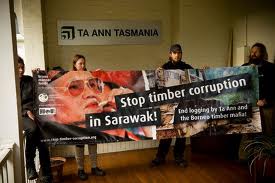
.
.
Tasmanian protests ongoing to save Tasmanian Forests
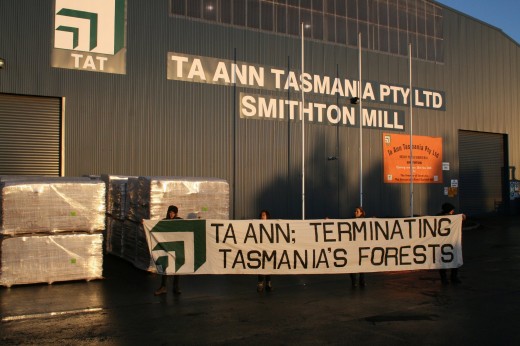 Ta Ann’s mill at Smithton Ta Ann’s mill at Smithton
.
This morning, grassroots forest groups the Huon Valley Environment Centre, Still Wild Still Threatened and Code Green have taken action at the Ta Ann veneer mill in Smithton. Twelve conservationists entered the site at 6am and two activists are locked on to machinery, halting operations. The protestors are displaying a banner reading ‘Ta Ann terminating Tasmanian forests‘.
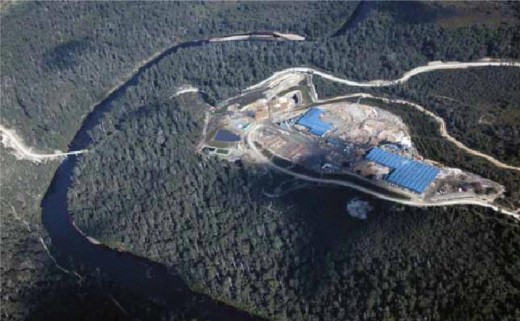 Ta Ann’s mill carved into the forests in Tasmania’s Huon Valley Ta Ann’s mill carved into the forests in Tasmania’s Huon Valley
.
This action takes place in response to Ta Ann’s role in blocking a solution for Tasmania’s forests. Grassroots environment groups are raising concerns over yesterday’s Intergovernmental Agreement on forest.
“We are aware of Ta Ann’s shocking environmental and human rights practices in Sarawak and we are raising the question to the State and Federal government – why is this exploitative Malaysian company allowed to continue destroying our forests and threaten Tasmania’s chance to move forward to a sustainable industry?” said Code Green spokesperson, Joanna Pinkiewicz.
.
“Yesterday’s agreement guarantees Ta Ann’s contract until at least 2027.
This Malaysian logging giant has a deplorable record in (Indonesia’s) Sarawak and are now entrenching large scale clear felling of native forests in Tasmania”
.
~ Huon Valley Environment Centre spokesperson Jenny Weber.
.
“The intergovernmental Agreement leaves open over 140,000 hectares of identified high conservation value forest to potential logging. Contracts with companies such as Ta Ann could jeopardise the future protection of high conservation value forests, with further reductions to the reserve area still on the table” said Still Wild Still Threatened spokesperson Miranda Gibson.
“While we look forward to seeing high conservation value forests protected, the real hurdles are yet to come. This agreement is a first step that has not yet guaranteed formal protection of these forests, that is long overdue” said Ms Weber.
.
[Source: ‘Ta Ann Mill Shut Down‘, 201108122, ^http://hornbillunleashed.wordpress.com/2011/08/12/22368/]
.
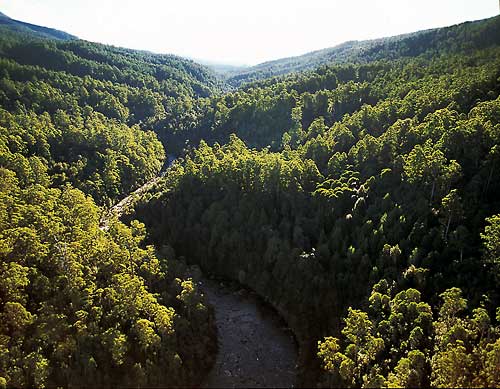 Tasmania’s Weld Valley – being logged by Ta Ann
(Photo by Rob Blakers)
http://www.water-sos.org/rob-blakers4.html Tasmania’s Weld Valley – being logged by Ta Ann
(Photo by Rob Blakers)
http://www.water-sos.org/rob-blakers4.html
.
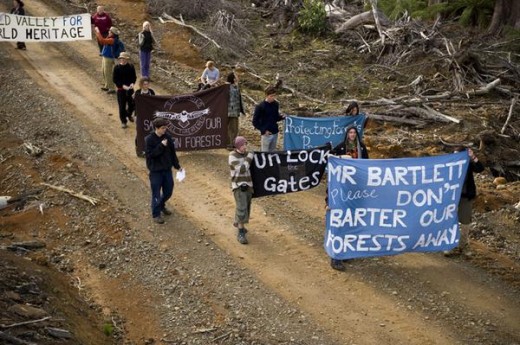 Human Plea Human Plea
.
.
Tags: 572000 hectares, Abdul Hamed Sepawi, Chain of Custody certification, Daiwa, eco-rapists, Emerging Exporter Award, Forestry Stewardship Council, Forestry Tasmania, FSC International, Huon Valley Environment Centre, Intergovernmental Agreement, JATAN, log and flog Tasmanian Rorests, old growth forest, Panasonic Electric Works, Peter Cundall, Sarawak, Sekisui, Ta Ann Tasmania
Posted in Kalimantan (ID), Tasmania (AU), Threats from Deforestation, Threats to Wild Tasmania | 1 Comment »
Add this post to Del.icio.us - Digg
Friday, October 21st, 2011
 Stihl Concrete Saw Stihl Concrete Saw
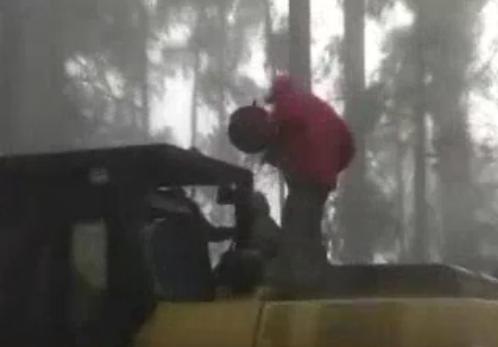 Stihl Saw Nutter – contracted with Forestry Tasmania, October 2008 Stihl Saw Nutter – contracted with Forestry Tasmania, October 2008
(Click photo above to play video in YouTube, turn up your PC volume)
.
 Stihl President – Fred Whyte
(Billings Gazette) Stihl President – Fred Whyte
(Billings Gazette)
.
In September 2010, Fred J. Whyte, president of STIHL Inc., was elected chairman of the Outdoor Power Equipment Institute (OPEI) during the association’s 58th annual meeting in Coeur D’Alene, Idaho.
.
“I am honored to again represent STIHL and the outdoor power equipment industry as chairman of the OPEI board,” said Whyte.
“In this next year, we hope to accomplish a lot, especially in the realm of educating the public on the safe and efficient use of outdoor power equipment. We are seeing gains in the market, which should be welcome news to all OPEI members. Let’s hope we return to our market prosperity with new sustainable programs and products that will lead us into the next generation.”
.
[Source: Stihl USA, ^http://www.stihlusa.com/pressrelease/september10_FJWOPEI_corporate.aspx]
.
.
Two years prior (2006) …’Defending Tasmania’s ancient forest’
.
[Source: Tasmanian Times, 20061106, ^http://tasmaniantimes.com/index.php?/article/defending-tasmanias-ancient-forest/ ]
.
‘This week has marked a new chapter in the defence of Tasmania’s ancient forests with 17 arrests in the Weld Valley, Southern Tasmania.The arrests occured whilst community members were trying to prevent an access road that will allow the chainsaws into majestic ancient forests.The Weld Valley has now become one of the largest resistance campaigns for Tasmania’s forests in the last decade. Community outrage at this senseless devastation is challenging the Tasmanian and Australian governments to give these wilderness forests the protection they deserve.
For more than a year, forest defenders built and lived in a beautiful conservation haven that worked to hold the chainsaws and bulldozers at bay. Camp Weld, had a full size replica Pirate ship (the Weld Ark), a bush cabin and the entire infrastructure needed to provide shelter and support to friends of the forest. The camp had a village style atmosphere and was open to all comers who wanted to help the forests in their plight. Camp Weld members faced not only the hostility of the weather, the driving rain, winter dark and snow but also the very real hostility and threats from logging industry supporters.
.
‘Through the year, Camp Weld faced gun shots, car burnings and physical threats from loggers coming directly into camp.’
.
All this was greeted with the strength and commitment of non-violent action and this peaceful response is a testament to the bravery and beauty of the people who lived there.
On Wed 15th November 2006, more than 60 Police raided the camp with one immediate arrest and a lone tree-sitter escaping to her lofty perch.Everyone else was ordered to leave or face arrest under a new media and public exclusion zone placed around a 10 kilometre radius of this state owned forest. For the next 6 days a set of rolling actions began and continue, flowing from the anger at the loss of such a direct action icon and the coming loss of these wondrous forests. People climbed tree-sits, stood in front of machines and some forest defenders locked theselves on to machinery. These actions occurred day after day as the arrest tally climbed to the present 17.
.
For 5 days, the lone tree sitter ‘Pixie’ sat in her high platform watching the events unfold..
Two other forest defenders spent nights in jail as Police used legal tactics to try and prevent the arrestees from returning to the forests. The Tasmanian government has funded this operation to secure access for Gunns Ltd, providing large numbers of police, security, a 24 hour mobile operations base and satellite communications equipment, all to ensure that the bulldozers get into the forest. Yet despite these obstacles people continue to challenge the destruction in a peaceful and defiant manner.
.
Classic non-violent style
.
On two separate occasions, a community walk in was staged to defy the archaic exclusion zone created on public land. The first walk in had 40 people, the second over 100. These were great days for the forests as smiling people walked past security and police, in classic non-violent style. The strength in numbers meant that the police were unable to implement the exclusion zone procedures, which involves individually approaching each person in the zone. The veil over this hideous environmental crime had been lifted.This type of protest has occurred because of the continued failure of the Regional Forest Agreement (RFA) and the subsequent Community Forest Agreement, which were set up under the pretence to solve the forest debate in Tasmania. In fact, things in the forest have gotten worse, roads continue to be cut into high conservation value forests and logging is planned for many high conservation value forests and wilderness areas across the state. A downturn in the woodchip market has not deterred the world largest hardwood woodchipper, Gunns Ltd from continuing their devastation of the island’s wildlife and trees. Their aggressive response to criticism is to sue conservationists and environmental groups with a blanket multi-million dollar civil case.This almost billion dollar company and its $65million man, John Gay, have a strangle hold on the states politicians and its old growth forests.
The Weld Valley is a shining example of places ignored by the chainsaw mandate of the RFA; it is an ancient forested valley of towering trees, moss filled rainforest gullies, snow-capped mountains, wide plains, crystal clear streams and wild Weld river. The original Tasmanians wandered this valley some 20,000 years ago evidence of their lives still remain in the national park protected ‘Bone Cave’ in the upper Weld. The potential for more sites or caves remains unexplored in much of the logging slated lower Weld Valley. While some 80% is protected in the South West World Heritage Area, the remaining forests suffer a very different fate to those separated by the imaginary protection line.
These remaining forests of the lower Weld Valley have been recognized by local and international environmental groups, the United Nations and even Tasmania’s Parks and Wildlife as having equal conservation status to the rest of the valley. Viewed as a single wilderness area, the Weld Valley is a unique landform which has a rare combination of outstanding biological, geological and cultural features naturally linked by continuous forest to the World Heritage Area.
Direct action has always been an area of last resort for conservationist. Brave and often reluctant heroes staff this front line with sometimes little more than their own bodies. Placing lives on hold and committing all for the forests. Basing actions on non-violent principles, that has served people and social movements like Gandhi, the Suffragettes, the Civil Rights struggle and our own Franklin River campaign. As long as companies like Gunns Ltd are allowed, by governments, to ignore community concern and run rampant through our ancient forests with chainsaws and bulldozers then there will always be people willing to stand in their defence.’
.
[Adam Burling is a founding member of the Huon Valley Environment Centre, a part time advisor to Senator Bob Brown and a Gunns 20 defendant.]
.
Tags: activists, Camp Weld, Caterpillar, Community Forest Agreement, Direct action, forester violence, Forestry Tasmania, Fred Whyte, Logging, Martin Bryant, old growth forest, Outdoor Power Equipment Institute, stihl chainsawing old-growth, STIHL Inc., Stihl President, Stihl Saw, Stihl Saw Nutter, Stihl woodchipping old growth, Tasmanian Police, Weld Valley, William Adams, World Heritage Area, www.stihlusa.com
Posted in Tasmania (AU), Threats from Deforestation, Threats to Wild Tasmania | No Comments »
Add this post to Del.icio.us - Digg
Thursday, October 13th, 2011
If you go down into the woods today you’re sure in for a big surprise…but in Tasmania’s South-West it ain’t no teddy bear’s picnic.
One has to first get past the many infamous locked gates. Forestry Tasmania (aka the State-sanctioned corporate logger) is sure to have locked its steel gates for very good reason – Forestry Tasmania doesn’t want the public to know the truth about what it is doing to Tasmania’s remaining wild forests.
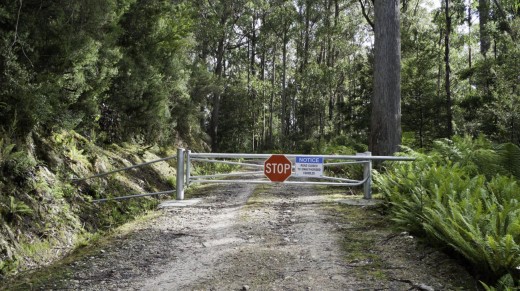 Forestry Tasmania’s locked gate on the public road to the top of Mount Tim Shea
(Suspiciously this public access road was deemed unfit for public travel coincidentally around the same time as Forestry Tasmania opened its ‘Adventure Hub’ in Maydena,
and equally coincidentally one of the hills they charge people for a ride to the top from reads ‘Adventure Hub’).
(Photo by Alan Lesheim) Forestry Tasmania’s locked gate on the public road to the top of Mount Tim Shea
(Suspiciously this public access road was deemed unfit for public travel coincidentally around the same time as Forestry Tasmania opened its ‘Adventure Hub’ in Maydena,
and equally coincidentally one of the hills they charge people for a ride to the top from reads ‘Adventure Hub’).
(Photo by Alan Lesheim)
.
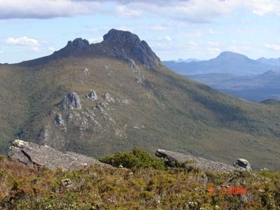 Rugged Mount Tim Shea, South-West Tasmania Rugged Mount Tim Shea, South-West Tasmania
Photo by Forestry Tasmania
^http://www.forestrytas.com.au/topics/2008/06/maydena-adventure-hub-opportunities
.
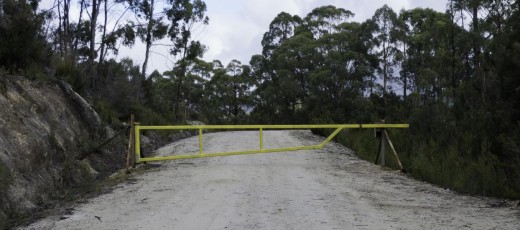 Locked Gate on Five Road in the Upper Florentine Locked Gate on Five Road in the Upper Florentine
(connects to Cook’s Track which enters the Gordon River Road short of Camp Flozza)
(Photo by Alan Lesheim)
.
Forestry Tasmania has hundreds of these padlocked gates throughout Tasmania’s wild forests.
The Wilderness Society’s spokesperson Amanda Sully said “Forestry Tasmania have a locked boom gate over the Huon Valley Wilderness and are refusing entry. This is just one of hundreds of gates on forestry roads in Tasmania.
“It’s very clear who is locking up the forests. People are sick and tired of seeing log truck after log truck coming from the clear felling behind these padlocked gates.
These are publicly-owned forests.
Forestry Tasmania is supposed to manage them for the benefit of all Tasmanians, not just the loggers” Ms Sully concluded.
.
[Source: ‘Forestry Tasmania – Locking up our forests‘, ^http://www.wilderness.org.au/campaigns/forests/19980924_mr
.
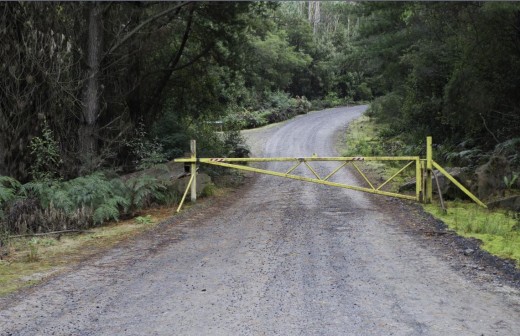 Forestry Locked Gate on Blue Road, northern section of the Upper Florentine Valley Forestry Locked Gate on Blue Road, northern section of the Upper Florentine Valley
(Photo by Alan Lesheim)
.
.
Author Anna Krien was on a quest for the truth described in her revealing expose book of 2010 into what’s stihl happening in Tasmania’s wild forests:
~
‘Most people travelling through Tasmania will never know of the long-running hide-and-seek taking place in the labyrinth of logging roads beyond the bitumen.
Sightseers walk among 300-year-old trees, some of them 90 metres tall, in the Styx Big Tree Reserve, chainsaws can be heard in the distance.
The road into this attraction is lined with stage sets of wilderness.
At the rise of a hill, just before the nose of the car tilts downwards, passengers might glimpse a balding peak, a fleeting insight into the world behind the verge.’
~
[Source: ‘Into the Woods: The Battle for Tasmania’s Forests‘, 2010 by Anna Krien pp.25-26, published by Black Inc. ^http://www.blackincbooks.com/books/woods, includes video interviews].
.
So, this Editor, half way through the book, last month flew down to Hobart, hired a car and retraced the author’s journey into Tasmania’s South-West …
.
 Driving west along the old Hydro Electrical Commission’s (HEC) Gordon River (Access) Road,
through Forestry’s logging town of ‘Westerway’ Driving west along the old Hydro Electrical Commission’s (HEC) Gordon River (Access) Road,
through Forestry’s logging town of ‘Westerway’
.
Noticeably, when driving out of Hobart I passed clearly wealthy residential suburbs, yet driving along the Gordon River Road these few isolated hamlets are not wealthy. Their construction mostly seems temporary like mining companies would construct while the mine delivers. The highway through the hamlets of Westerway, Fitzgerald and Maydena seems only for forest access, not for community.
I parked the car and walked through Maydena.
There is only the odd person out and about. The place seems impoverished – one small primary school, a notable lack of shops, lack of amenities, and little sign of any vibrant community.
It’s as if the profits from logging have driven right through the guts of these local villages and on to big corporations eastward.
.
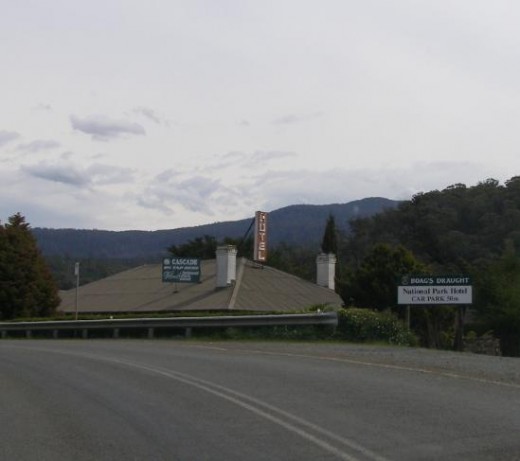 Past the National Park Hotel
where Tasmania’s champion wood-chopper ‘Big Dave’ holds pride of place above the pub’s fire place. Past the National Park Hotel
where Tasmania’s champion wood-chopper ‘Big Dave’ holds pride of place above the pub’s fire place.
.
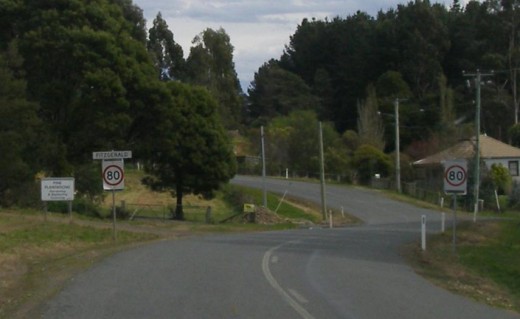 Driving through Forestry’s old logging town of ‘Fitzgerald’
. Driving through Forestry’s old logging town of ‘Fitzgerald’
.
.
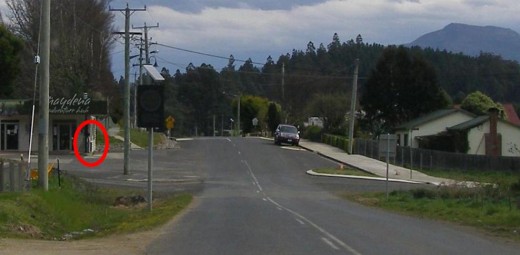 Driving through the old logging town of ‘Maydena’
– a closed so-called ‘Adventure Hub’ on the left, yet its diesel bowser (circled) open for Forestry Tasmania vehicles and observed in used by Editor 20110928. Driving through the old logging town of ‘Maydena’
– a closed so-called ‘Adventure Hub’ on the left, yet its diesel bowser (circled) open for Forestry Tasmania vehicles and observed in used by Editor 20110928.
.
Reminiscent of Australia’s 1850s Gold Rush, Tasmanian folk would have been lured west by Forestry to the promise of bountiful tall timber delivering reliable logging income and the promise of building personal wealth.
But along the Gordon River Road there is a stark absence of Forestry wealth. Instead it seems Forestry has abandoned these Gordon River Road communities.
What Forestry has done is to sell out Tasmania’s traditional woodcraft industry for short term profit from flogging quality Tasmanian hardwood as cheap asian woodchips, destroying Tasmania’s forests timber communities in the process. Then Gunns got greedy and Tasmania’s timber reputation has deteriorated thereafter.
Now Forestry Tasmania are clearfelling and selling out Tasmania’s rare forests to the asians direct, to the likes of Ta Ann. Forestry Tasmania is no more than a corporate pimp of Tasmanian rare forest heritage.
.
“The road into this attraction is lined with stage sets of wilderness.”
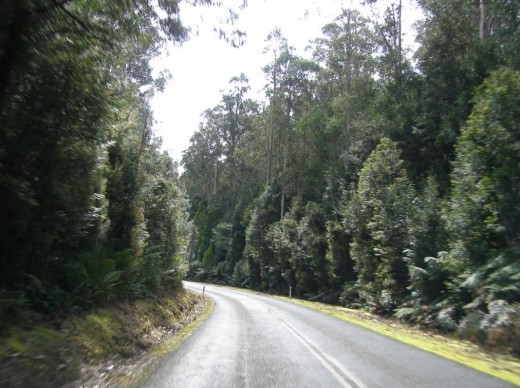 Driving further west along the HEC Gordon River Road
– bulldozed in 1964 through 64km of pristine wilderness forest by the Hydro Electric Commission, and
funded by the then Menzies federal government at a cost of £2.5 million (likely twenty times that in today’s terms – i.e. $50 million.
. Driving further west along the HEC Gordon River Road
– bulldozed in 1964 through 64km of pristine wilderness forest by the Hydro Electric Commission, and
funded by the then Menzies federal government at a cost of £2.5 million (likely twenty times that in today’s terms – i.e. $50 million.
.
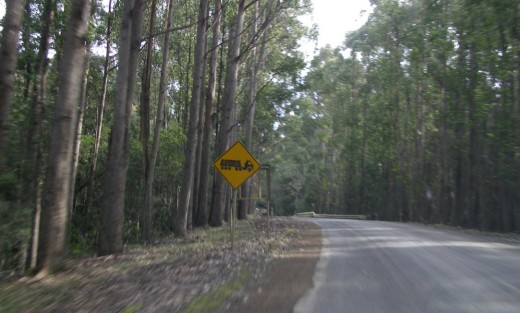 Gordon River Road – signposted logging country Gordon River Road – signposted logging country
.
“At the rise of a hill, just before the nose of the car tilts downwards, passengers might glimpse a balding peak”
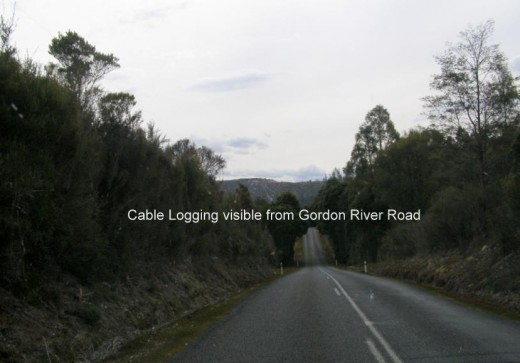 The balding peak of Forestry Tasmania’s cable logging…’a fleeting insight into the world behind the verge’.
(Photo by editor 20110928 while on Gordon River Road heading west) The balding peak of Forestry Tasmania’s cable logging…’a fleeting insight into the world behind the verge’.
(Photo by editor 20110928 while on Gordon River Road heading west)
.
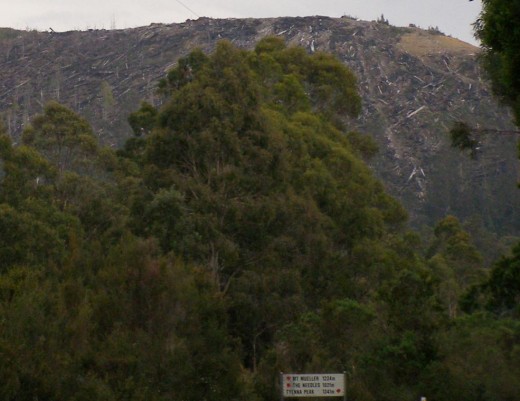 An entire hill of wild Tasmanian forest savagely cabled logged bare by Forestry Tasmania
Tourists can now see this from Gordon River Road.
(Photo by editor 20110928. Click photo to enlarge.)
An entire hill of wild Tasmanian forest savagely cabled logged bare by Forestry Tasmania
Tourists can now see this from Gordon River Road.
(Photo by editor 20110928. Click photo to enlarge.)
.
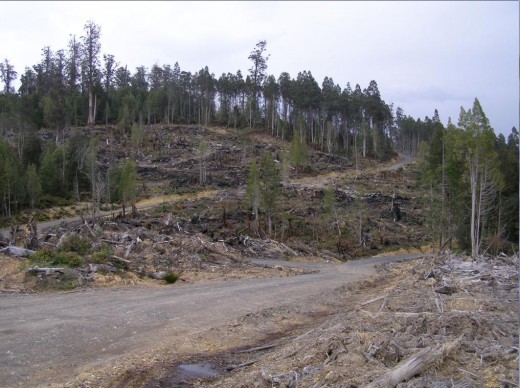 Beyond the lock gates lies the ecological holocaust
(Photo by editor 20110928. Click photo to enlarge.) Beyond the lock gates lies the ecological holocaust
(Photo by editor 20110928. Click photo to enlarge.)
.
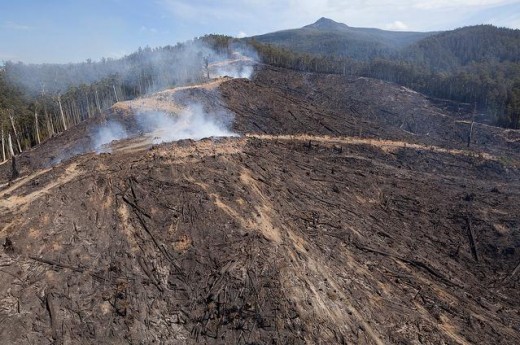 Styx Valley Holocaust
(Photo by Rob Blakers) Styx Valley Holocaust
(Photo by Rob Blakers)
.
 Tasmania’ s Styx Holocaust
September 2011 (Photo by Alan Lesheim)
Tasmania’ s Styx Holocaust
September 2011 (Photo by Alan Lesheim)
.
 Forestry Tasmania’s Killing Fields
Forestry Tasmania’s Killing Fields
.
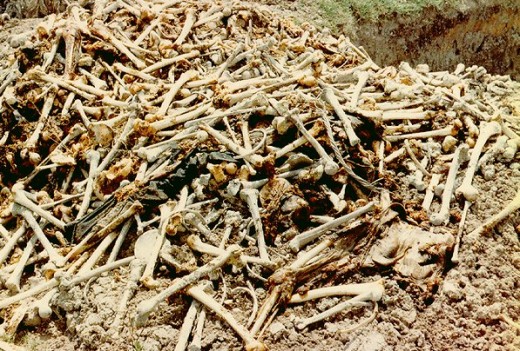 Cambodia’s Khmer Rouge Killing Fields
(Human mass murder comparable to Tasmania’s mass forest murder
– both crimes consistently against life) Cambodia’s Khmer Rouge Killing Fields
(Human mass murder comparable to Tasmania’s mass forest murder
– both crimes consistently against life)
.
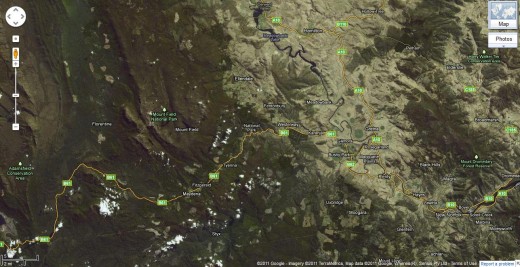 Google Maps (September 2011) satellite view of the forest rape by Forestry Tasmania
.
Google Maps (September 2011) satellite view of the forest rape by Forestry Tasmania
.
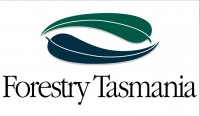 . .
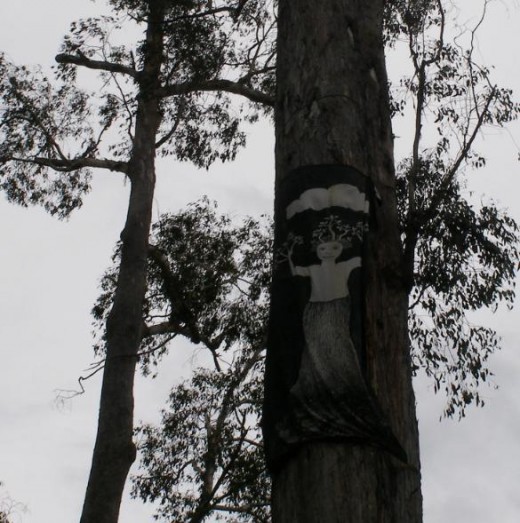 Camp Flozza’s symbolic goddess of the ancient Florentine Forest
~ eco-raped by Forestry Tasmania in its January 2009 raid
Camp Flozza’s symbolic goddess of the ancient Florentine Forest
~ eco-raped by Forestry Tasmania in its January 2009 raid
.
 And they wonder why the people protest and are prepared to be arrested?
(Photo of forest defender being arrested at Forestry Tasmania’s police raid on Camp Flozza,
Upper Florentine Valley, 13th January 2009) And they wonder why the people protest and are prepared to be arrested?
(Photo of forest defender being arrested at Forestry Tasmania’s police raid on Camp Flozza,
Upper Florentine Valley, 13th January 2009)
.
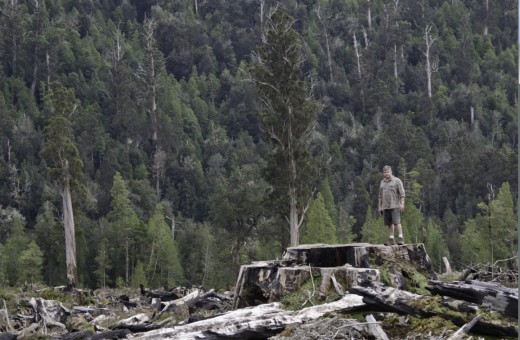 Styx Valley Holocaust by Forestry Tasmania, September 2011
(Photo of editor 20110928. Click photo to enlarge.)
Styx Valley Holocaust by Forestry Tasmania, September 2011
(Photo of editor 20110928. Click photo to enlarge.)
.
.
Forestry Tasmania padlocks gates 10 kilometres from clearfell around a protected Wedge-tailed Eagle nest
[Source: ‘Loggers breach eagle nest protection laws again‘, Bob Brown, 20090827, ^http://bob-brown.greensmps.org.au/category/issues/environment/forestry/wielangta]
‘In the breeding season, a clear felling operation in Tasmania’s wild Upper Huon Valley has breached guidelines by smashing down forests next to an endangered Tasmania’s Wedge-tailed eagles’ nest. The Tasmanian Wedge-tailed eagle, with wingspan up to 3 metres, are one of the Earth’s 6 largest eagle species.
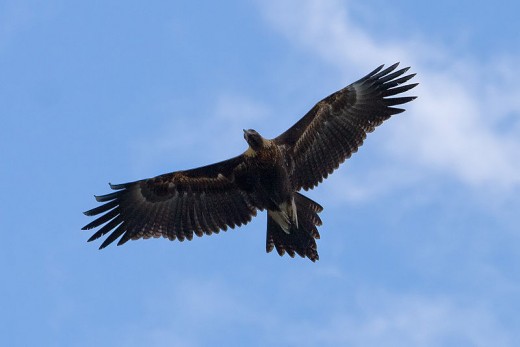
“After repeated controversies about woodchip operations burning or destroying eagle nests and causing failure of nesting because of bulldozers and chainsaws operations near nests, this failure of protection in the Huon is inexcusable. It makes a mockery of logging industry propaganda,” said Australian Greens Leader Bob Brown.
“The Ministers for Forestry and Environment who are responsible for Australia’s rare and endangered species don’t know, and don’t act in any helpful way.”
“It is as if the Howard Government never left office. These ministers have washed their hands of their role in the Wedge-tailed eagles’ fate. Logging laws in Tasmania state that a minimum of 10 hectares be left around an eagle’s nest,” said Senator Brown.
Forestry Tasmania has erected locked gates 10 kilometres from the nest logging site preventing public or media inspection.’
.
Footage of the logged area and nest available here (on YouTube):

.
.
Meanwhile Forestry Tasmania on its ‘Adventure Forests‘ website promotes its ‘Top of the World Tour‘ from Maydena…

…’Go wild where eagles soar…Make the escape to the Eagle’s Eyrie on a Top of the World Tour.You’ll experience all the fun of the Railtrack Rider as you travel into the heart of the forest to explore long-abandoned bush heritage, before emerging to an alpine wonderland and an eagle’s eye view over the Tasmanian wilderness. There’s plenty of time for indulgence as well, with an individually-prepared gourmet lunchbox and fine regional wines enjoyed in the fireside comfort of the Eagles Eyrie.’
^http://adventureforests.com.au/maydena
.
.
‘The real voyage of discovery consists not in seeking new landscapes
but having new eyes’
~ Marcel Proust, French novelist
Tags: Anna Krien, Cable Logging, Camp Flozza, deforestation, Fitzgerald, Florentine Valley Holocaust, Forestry Holocaust, Forestry Locked Gates, Forestry Tasmania, Gordon River Road, having new eyes, Into the Woods, Maydena, Maydena Adventure Hub, Mount Tim Shea, National Park hotel, Styx Big Tree Reserve, Styx Forest, Styx Valley, Styx Valley Holocaust, Ta Ann, Tasmania, Tasmania's Ancient Forests, Tasmania's South West, Tasmania's Wild Forests, Upper Florentine Forest, Wedge-tailed Eagle, Westerway, wild forests
Posted in Eagles, Tasmania (AU), Threats from Deforestation, Threats to Wild Tasmania | No Comments »
Add this post to Del.icio.us - Digg
Monday, October 10th, 2011
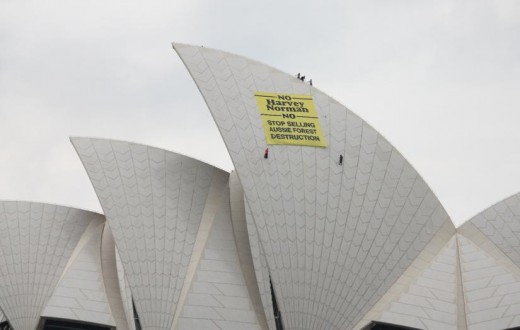 Last Saturday, forest activists scaled Sydney’s Opera House and unfurled a huge banner reading: Last Saturday, forest activists scaled Sydney’s Opera House and unfurled a huge banner reading:
‘No Harvey No! Stop selling Aussie forest destruction’!
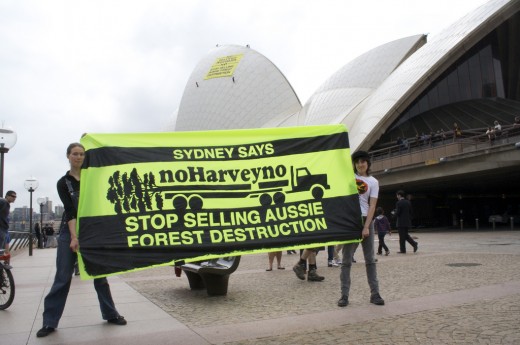
“We have come to the centre of Sydney to send a clear message to Harvey Norman that profiting from the destruction of our spectacular forests is absolutely unacceptable’ said Ula Majewski, spokesperson for The Last Stand.”
‘Our internationally iconic Aussie forests are still being destroyed by industrial logging operations. We are taking peaceful action from the top of another great Aussie icon to tell Harvey Norman that selling Aussie forest destruction is no way to do business’ said Miranda Gibson, currently perched atop the Opera House..
~ The Last Stand Inc.
^http://www.thelaststand.org.au
[Source: ^http://tasmaniantimes.com/index.php?/weblog/article/forest-activists-scale-the-sydney-opera-house/]
.
 
.
Why do forest activists scale the Sydney Opera House to protest their message?

They personally risk their lives, are arrested, put in gaol; and in these days of corporate background checks, are denied corporate employment for the rest of their lives.
How many of our readers realise the seriousness of these young people and their moral custodial commitment to fighting for the protestion of Australia’s remaining and irreplaceable ancient forest ecosystems? Australia’s youth represent and prepared to be incarcerated to protect Australia’s natural heritage. These protesters in generations to come, when the economic bigotry has died, will be venerated as Australian diggers defending what is uniquely Australian.
While the mainstream media are more interested in a commercial football match in Auckland that comes around and goes around, the vicious industrial lumberjacks in Forestry Tasmania, Forestry Victoria, and Forestry New South Wales (or whatever their rebranded name) are daily decimating vast hectares of Australia’s wild native forests. This State-sanctioned ecological massacre of old growth forests is the core reason why Australia has been internationally degraded with a backward reputation for recording the highest rates of wildlife extinction in the 21st Century. Australia is down their in ecological degradation with Zimbabwe, Rwanda and Mozambique.
Why do forest activists scale the Sydney Opera House to protest their message?
Well, start to appreciate the grassroots struggle that has for years been unreported by the mainstream media…
.
‘Conservationist halt roading operations in the iconic Styx valley’
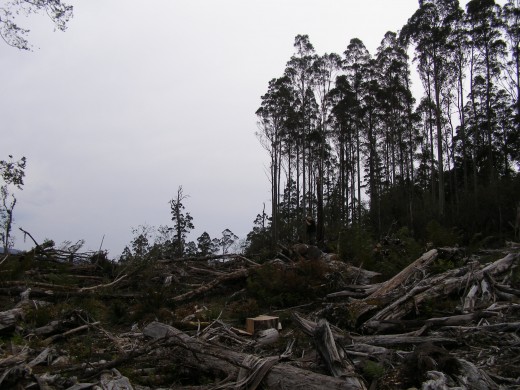
Tasmania’s ancient Styx Forest slaughtered for Malaysian woodchips,
continuing to be subject to Forestry Tasmania holocaust
– utter clearfell followed by blanketed incineration so that the old forest is obliterated forever
– just like what the Nazi’s did to the Jews – out of sight out of mind, until the war was over.
(Photo by editor 20110928, free in public domain, click to enlarge and then click to enlarge again)
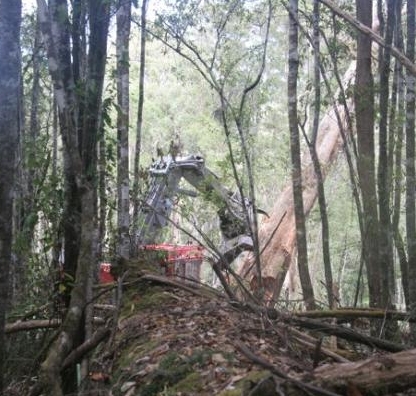
‘Today twelve conservationists have halted a new roading operation in the Styx Valley as part of a ten week campaign to highlight the urgent need for Tasmania’s high conservation value forests to be protected. The recently started roading operation leads to Coupe SX038D and is within a high conservation value area proposed for formal reserve. One protester is in a tree sit, which is attached to roading machinery, preventing any operations from continuing for the day.
.
“The fact that a new road is currently being pushed into high conservation value forest in a area that should have been under moratorium weeks ago, is a clear indication that Forestry Tasmania are not taking appropriate action to reschedule coupes and implement the moratorium” said Miranda Gibson, spokesperson from Still Wild Still Threatened.
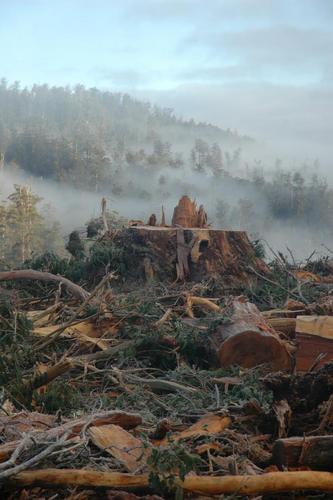
“How can the Tasmanian community have faith in Forestry Tasmania when they have not only failed to meet the moratorium deadline, but are now blatantly disregarding government directive to reschedule coupes? If Forestry Tasmania were serious about implementing the moratorium, they certainly would not be wasting taxpayers money investing in brand new roads to access iconic forests that have been earmarked for protection.” said Ms Gibson.’
.
[Source: Still Wild Still Threatened, 20110412, ^http://www.stillwildstillthreatened.org/main-categories/current-news]
.
 Maranda Gibson, defender of Tasmania’s forest heritage Maranda Gibson, defender of Tasmania’s forest heritage
One of the arrested protesters on the Opera House last Saturday
.
 . .
 Prepared to be arrested for Tasmanian principle Prepared to be arrested for Tasmanian principle
.
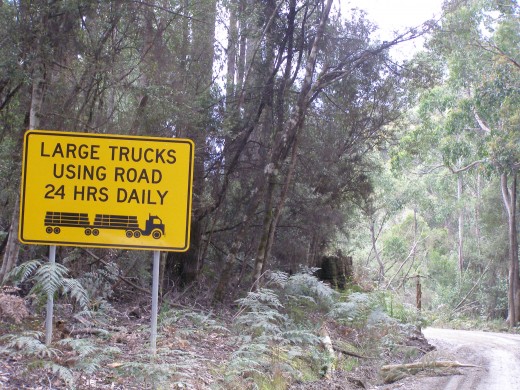 Styx Valley
Tasmania’s remaining wild forests..disappearing by Styx Valley
Tasmania’s remaining wild forests..disappearing by
…LARGE TRUCKS USING ROAD 24 HRS DAILY
.
.
Legal Sequel: ‘Opera House abseilers fined $200’
.
[Source: Sydney Morning Herald, 20111109, ^http://www.smh.com.au/environment/conservation/opera-house-abseilers-fined-200-20111109-1n6vv.html]
.
‘Three activists who scaled the Opera House, unfurling a banner bagging a retail giant, have been fined in a Sydney court. Miranda Gibson, 30, and Roseanne Phillips, 22, scaled the landmark on October 8 and abseiled from the western side of its western sail.
They unfurled a 10 by 12-metre yellow banner stating:
“No Harvey No! Stop selling Aussie forest destruction”
.
Scott Mackenzie, 37, also climbed to the top of the building carrying the banner on his back, but remained on the peak. They each pleaded guilty, in Downing Centre Local Court today, to a count of trespassing. Magistrate Janet Wahlquist fined them $200 each, plus court costs.
.
Outside court, Gibson, from the protest group The Last Stand, said the protesters had achieved their goal.
“We took action to bring the plight of our great and iconic native forests to another great Australian icon in the heart of Sydney, and to send a clear message to Harvey Norman that profiting from Aussie forest destruction is no way to do business in this day and age,”
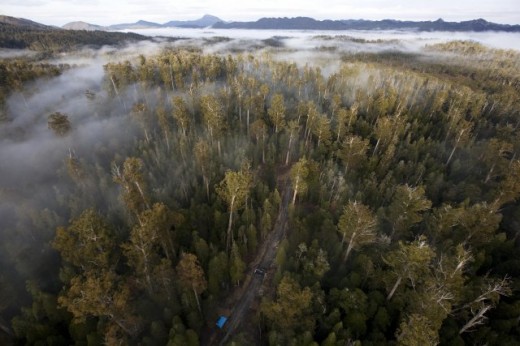
.
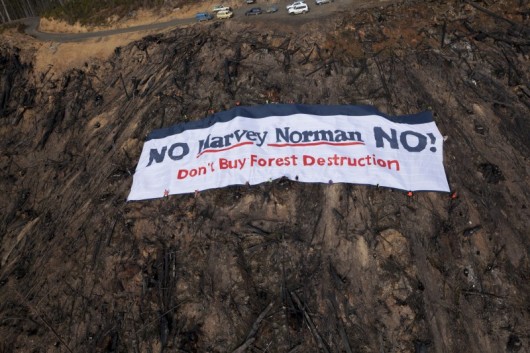 . .
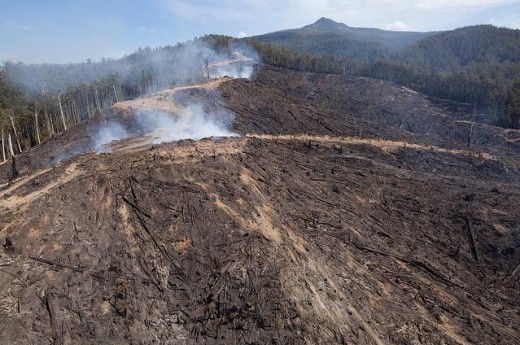 . .
 Fined $200 in NSW to dare to protest against destruction of Tasmania’s ancient native forests Fined $200 in NSW to dare to protest against destruction of Tasmania’s ancient native forests
.
.
The Last Stand has singled out Harvey Norman after a year-long investigation into its timber usage which, the protesters say, was contributing to the destruction of native forests.
They claim to have tracked timber from native forests in Australia through its shipment to China for processing into furniture, and then to its final sale in Australia through Harvey Norman stores.The store has previously said it was being unfairly targeted and did its best to source timber from sustainable sources.’
.
When will Gerry Harvey come clean on his personal profiting from native forests?
GO…search your morals Gerry Harvey!
 Tasmanian Devil
(Photo by Matthew Stewart, Flickr). Tasmanian Devil
(Photo by Matthew Stewart, Flickr).
.
Tags: a desperate cry, EKO Wood, forest network, Forestry Holocaust, Forestry Tasmania, Gerry Harvey, Go Harvey Norman, Go search your morals Gerry Harvey, Harvey Norman, Harvey Norman Flooring, Naturally Australian, No Harvey No, Still Wild Still Threatened, Stop selling Aussie forest destruction, Styx Valley, Sydney Opera House, The Last Stand
Posted in Tasmania (AU), Threats from Deforestation, Threats to Wild Tasmania | No Comments »
Add this post to Del.icio.us - Digg
Sunday, October 9th, 2011
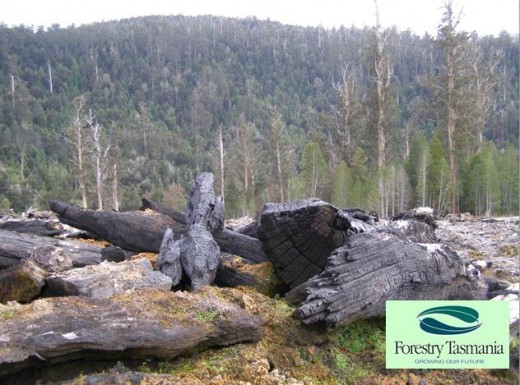 Forestry Tasmania – holocaust in Tasmania’s legendary Styx Valley
(Photo by editor, 20110928)
Forestry Tasmania – holocaust in Tasmania’s legendary Styx Valley
(Photo by editor, 20110928)
.
Selling Out Tasmania
First they came for the ancient Huon Pine and they exploited it —
The people accepted it because there seemed so much of it.
.
Then they came for the ancient Celery Top Pine, and they exploited it —
The people accepted it because there seemed so much of it.
.
Then they came for the ancient Eucalyptus regnans, and they exploited it —
The people accepted it because there seemed so much of it.
Then they came for the rest of Tasmania’s ancient forests —
until the ruling generation accepted it.. because they had never seen an ancient forest.
.
Previously, they had shot, poisoned and trapped Tasmania’s Thylacene —
because they imagined it killed their livestock —
The people accepted it because there seemed so many of them.
But they were all wrong,
as exploiters of the wild have inherently always been wrong.
Then the Thylacene was suddenly gone forever.
.
Since the timber getting has gone commercial, mechanical, industrial,
Tasmania’s once proud timbercraft tradition is vanishing with the forest.
.
When Tasmanians sell out to foreign dictators,
we betray Tasmania
When Australians become beholden to foreign dictators,
we betray our forefathers.
We are selling out Tasmania.
.
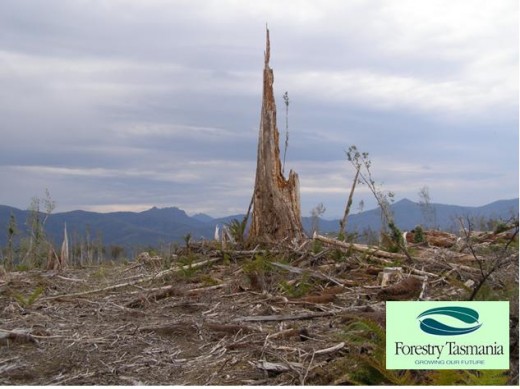 Forestry Tasmania – ‘growing whose future’?
(Photo by editor, 20110928)
Forestry Tasmania – ‘growing whose future’?
(Photo by editor, 20110928)
.
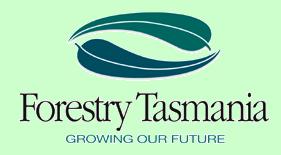 . .
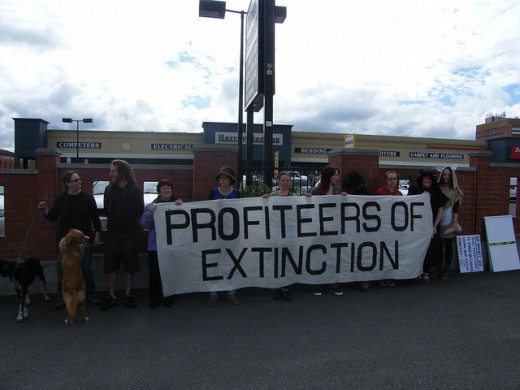 if the shoe fits… if the shoe fits…
.
[with apologies and respect to Martin Niemöller, who’s famous quotation about the Nazi Holocaust is apt in the current context of Forestry Tasmania’s extermination of Tasmania’s ancient forests.]
Tags: Celery Top Pine, Eucalytus globulus, forestry eugenics, Forestry Holocaust, Forestry Tasmania, growing our future, Huon Pine, Selling Out Tasmania, Styx Valley, Tasmanian holocaust, thylacene, Thylacene Bigotry
Posted in Tasmania (AU), Threats from Deforestation, Threats to Wild Tasmania | No Comments »
Add this post to Del.icio.us - Digg
Saturday, October 8th, 2011
Tasmania’s ancient Eucalyptus regnans of the Upper Florentine, South-West Tasmania…chainsawed in utter spite by Forestry Tasmania in its infamous forest raid on Tuesday 13th January 2009.
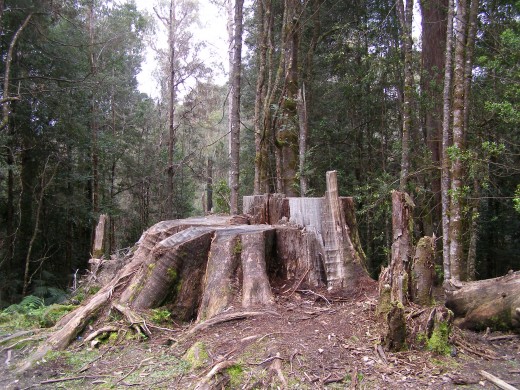 (Photo at Camp Flozza, Upper Florentine, South-West Tasmania, by editor 20110928,
Photo free as always in public domain – click to enlarge, then click to enlarge again)
(Photo at Camp Flozza, Upper Florentine, South-West Tasmania, by editor 20110928,
Photo free as always in public domain – click to enlarge, then click to enlarge again)
.
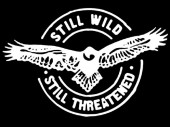 ^www.stillwildstillthreatened.org
^www.stillwildstillthreatened.org
.
‘There are people at Forestry who obviously don’t see green,
they see red..
The bunker mentality surfaces,
the big boots go in,
the chainsaws are fired up.
and ‘Common Sense’…goes out the window.’
[Source: Editorial, The Mercury, 20070219]
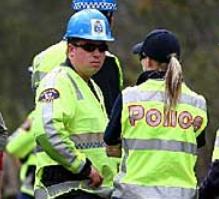
.
.
The 2009 Bartlett-Gordon Old Growth Massacre
 Then Tasmanian Premier David Bartlett Then Tasmanian Premier David Bartlett
.
 Then Forestry Tasmania Managing Director Bob Gordon Then Forestry Tasmania Managing Director Bob Gordon
.
13 January 2009: ‘Camp Floz Busted…Camp Flozza was raided by 60 cops this morning. They are back in force to ensure logging starts in the pristine Upper Florentine. They are held off by 3 conservationists in 50m high tree sits, 2 in cars locked to the road, and one in a tunnel.’
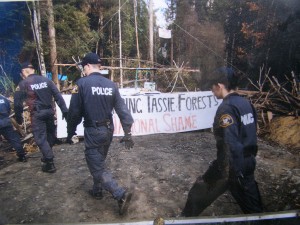 . .
‘Push came to shove in the Upper Florentine Valley yesterday. Scuffles broke out as about 200 protesters confronted a line of police blocking access to a contested logging road. Police arrested 15 people during yesterday’s Community Walk-In For the Florentine march.
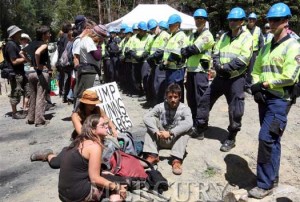
…Most of the old-growth forest to be cut in the area will become woodchips.
The two-year-old protest camp was destroyed on Tuesday although four protesters continued a vigil on two treetop platforms. They could be heard shouting their defiance throughout yesterday’s protest.
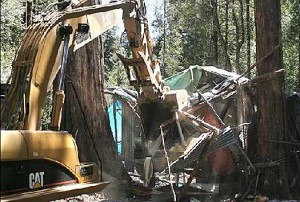
“It makes a mockery of the clever and kind Bartlett rhetoric when carbon-rich old-growth forests in an intact valley of World Heritage value are being opened up with a brand new logging road for clearfelling.” ~ Wilderness Society spokesman Vica Bayley.

Late yesterday, Derwent district forest manager Steve Whiteley said contractors had resumed work. “Our staff and contractors are cleaning up the site of Camp Florentine and undertaking road repair and construction,” he said. “We have had plans in place for several years to harvest a 50ha coupe and to build four kilometres of road.’

[Source: Arrests at Camp Flozza’, by David Killick, 20090114, ^http://www.themercury.com.au/article/2009/01/14/49611_tasmania-news.html]
.
.
‘Eyes that see much, and have so much seen’
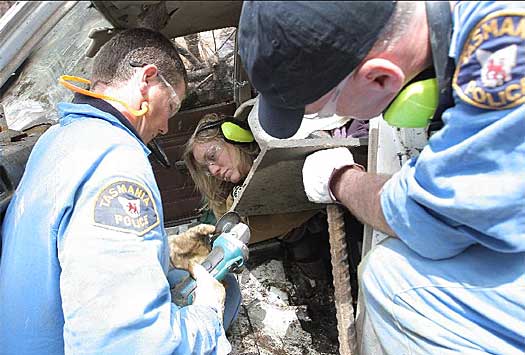 Taking a last stand to save Tasmania’s ancient forests
January 2009 police raid Camp Flozza, the front line defence of the Upper Florentine Forests Taking a last stand to save Tasmania’s ancient forests
January 2009 police raid Camp Flozza, the front line defence of the Upper Florentine Forests
.
 “Here’s to the crazy ones, the misfits, the rebels, the troublemakers, the round pegs in the square holes “Here’s to the crazy ones, the misfits, the rebels, the troublemakers, the round pegs in the square holes
… the ones who see things differently — they’re not fond of rules… You can quote them, disagree with them, glorify or vilify them, but the only thing you can’t do is ignore them because they change things… they push the human race forward,
and while some may see them as the crazy ones, we see genius,
because the ones who are crazy enough to think that they can change the world, are the ones who do.”
~ Steve Jobs (1995-2011)
.
.
O Brave.. ‘New Tasmania?’

Upper Florentine under current industrial attack from Forestry Tasmania
(Photo at Camp Flozza by editor 20110928, free in public domain – click to enlarge, then click to enlarge again)
.
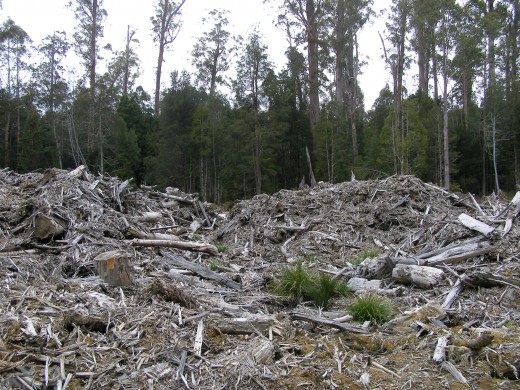 …those who come raiding at dawn.
(Photo at Camp Flozza by editor 20110928, free in public domain – click to enlarge, then click to enlarge again) …those who come raiding at dawn.
(Photo at Camp Flozza by editor 20110928, free in public domain – click to enlarge, then click to enlarge again)
.
‘The struggle for the soul of the island has raged for 200 years.
And it rages still, and still governments divide us against ourselves.
Resistance now is the staunch child of resistance past.
And it bodes for the future.’
~ Pete Hay
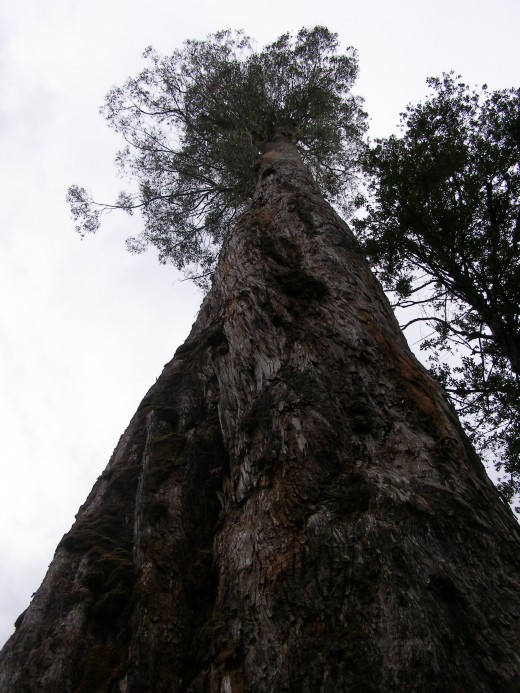 (Photo at Camp Flozza by editor 20110928, free in public domain – click to enlarge, then click to enlarge again)
(Photo at Camp Flozza by editor 20110928, free in public domain – click to enlarge, then click to enlarge again)
.
‘What must I do to protect you – he yells the trees…’
~ Barney Roberts
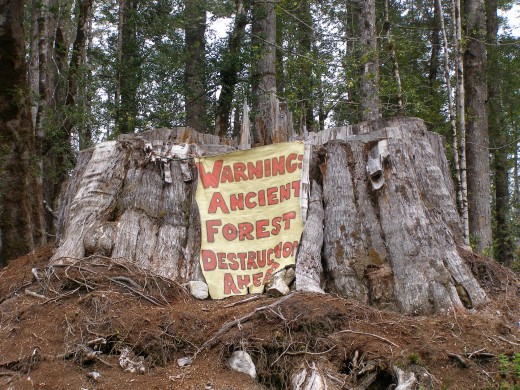 (Photo at Camp Flozza by editor 20110928, free in public domain – click to enlarge, then click to enlarge again) (Photo at Camp Flozza by editor 20110928, free in public domain – click to enlarge, then click to enlarge again)
.
 (Photo at Camp Flozza January 2009 by Sam Rosewarne, The Mercury newspaper)
(Photo at Camp Flozza January 2009 by Sam Rosewarne, The Mercury newspaper)
.
‘Documentary photography offers the future a view of the past.
It bears witness in an age when publications turn toward entertainment, celebrity and spin.
This is the history of Tasmania.
It should be documented.’
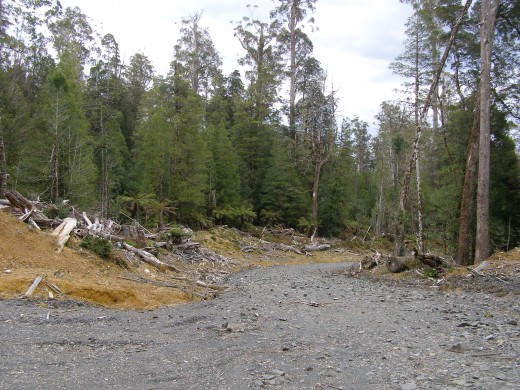 Foresty Tasmania ~ they came with 60 police,
they bulldozed their road through pristine old growth forest
(Photo at Camp Flozza by editor 20110928, free in public domain – click to enlarge, then click to enlarge again) Foresty Tasmania ~ they came with 60 police,
they bulldozed their road through pristine old growth forest
(Photo at Camp Flozza by editor 20110928, free in public domain – click to enlarge, then click to enlarge again)
.
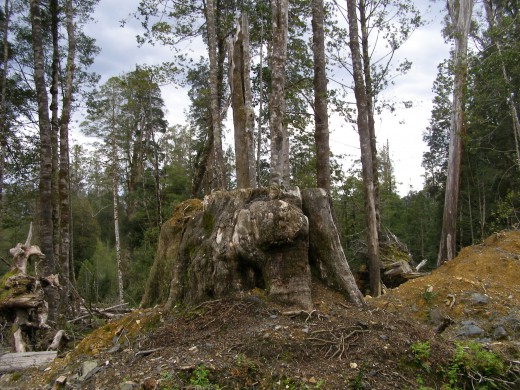 Forestry Spite
(Photo at Camp Flozza by editor 20110928, free in public domain – click to enlarge, then click to enlarge again) Forestry Spite
(Photo at Camp Flozza by editor 20110928, free in public domain – click to enlarge, then click to enlarge again)
.
[Quotes from Matt Newton & Pete Hay’s 2007 important photographic book , ‘The Forests’, ^http://www.matthewnewton.com.au/#/Documentary/The%20Forests/1]
.
.
Tags: 2009 Bartlett-Gordon Massacre, Bob Gordon, Camp Flozza, Chinese Imperial Dictatorship, David Bartlett, Eucalyptus regnans, forest exploitation, forestry spite, Forestry Tasmania, greedy commercial gain, Martin Niemöller, South-West Tasmania, Steve Jobs, Still Wild Still Threatened, Tasmania's holocaust, Tasmania's Thylacene, Tasmanian ancient forests, Upper Florentine Forest, utter spite
Posted in Tasmania (AU), Threats from Deforestation, Threats to Wild Tasmania | No Comments »
Add this post to Del.icio.us - Digg
Wednesday, October 5th, 2011
Every year after summer and upon the onset of winter, the outdoor pool at Katoomba Sports and Aquatic Centre, situated in Central Blue Mountains, is drained. Its contents including the chlorine (likely sodium hypochlorite) is emptied. The adjacent old plumbing between the pool and the dam, as well as repeated conductivity tests by the editor over multiple years under the Sydney Catchment Authority Streamwatch Programme point to the drainage being into the adjacent dam and into the Kedumba River; not into the sewer..
Reports of extreme water conductivity (off the scale… 500+ micro Siemens/cm) in the dam immediately following the draining the pool scale were sent to the Sydney Catchment Authority (SCA) , but nothing was ever done about it by the SCA.
This means every year, thousands of litres of chlorinated pool water flushes over Katoomba Falls and along the Kedumba River through the Greater Blue Mountains World Heritage Area.
It is therefore no surprise then that the Kedumba River looks clean – Blue Mountains Council ensures it is sterile of macro-invertebrates and river life.
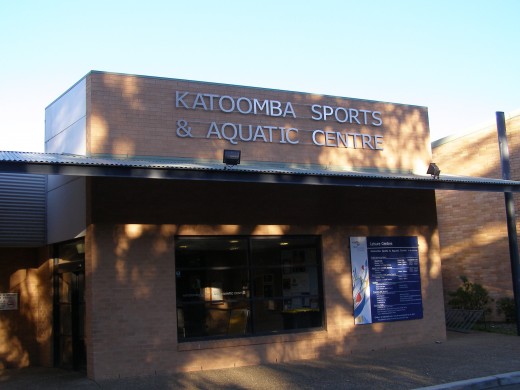 Katoomba Sports & Aquatic Centre
Blue Mountains, New South Wales, Australia Katoomba Sports & Aquatic Centre
Blue Mountains, New South Wales, Australia
.
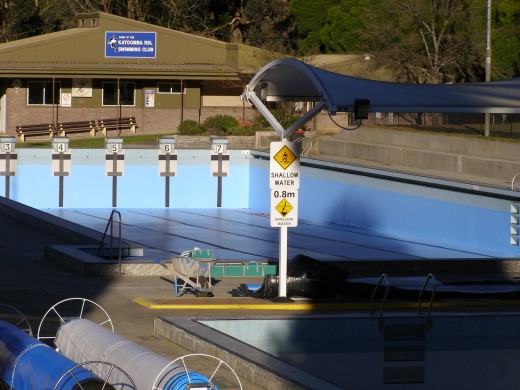 The Outdoor Pool of the Aquatic Centre…drained every winter
(Photo by Editor 20110516, free in public domain) The Outdoor Pool of the Aquatic Centre…drained every winter
(Photo by Editor 20110516, free in public domain)
.
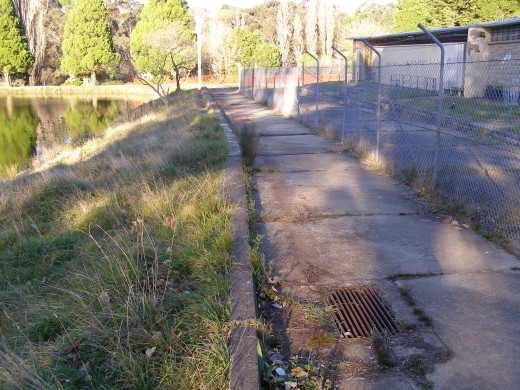 The Aquatic Centre was constructed conveniently adjacent to the Catalina Dam The Aquatic Centre was constructed conveniently adjacent to the Catalina Dam
.
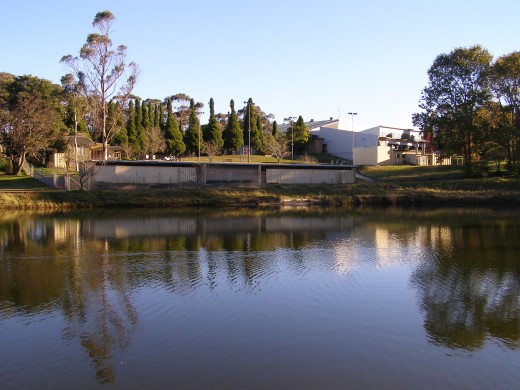 Catalina Dam, which in the late 1940s was glorified as a ‘lake’ by developer Horace Gates
Catalina Dam, which in the late 1940s was glorified as a ‘lake’ by developer Horace Gates
(designed with a flotation levelling system interconnected to adjacent Katoomba Falls Creek)
.
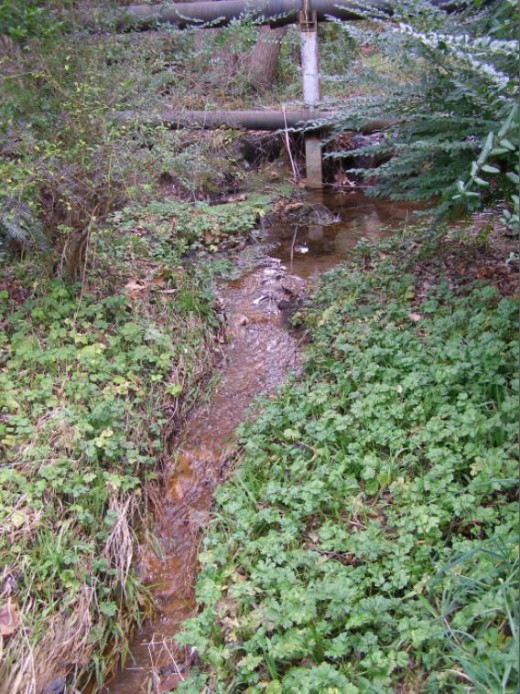 Upper Kedumba Creek downstream of Catalina Dam Upper Kedumba Creek downstream of Catalina Dam
.
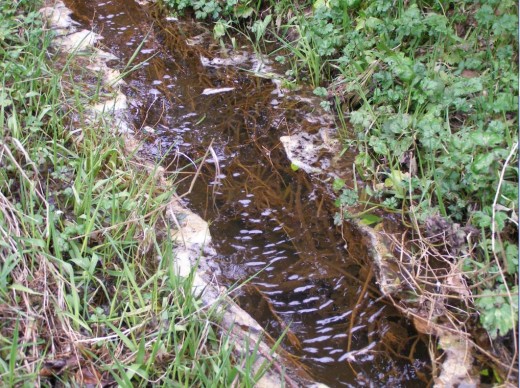 Upper Kedumba Creek downstream of Catalina Dam – close up Upper Kedumba Creek downstream of Catalina Dam – close up
.
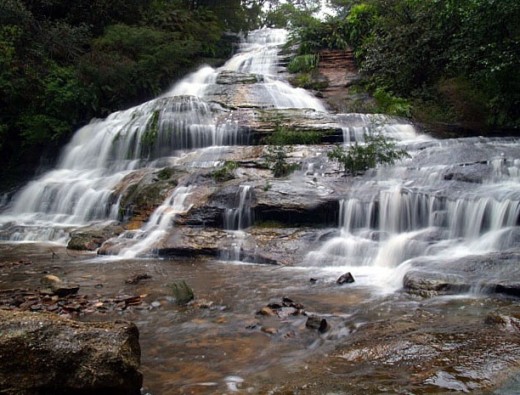 Katoomba Falls Creek naturally flows over Katoomba Falls Katoomba Falls Creek naturally flows over Katoomba Falls
.
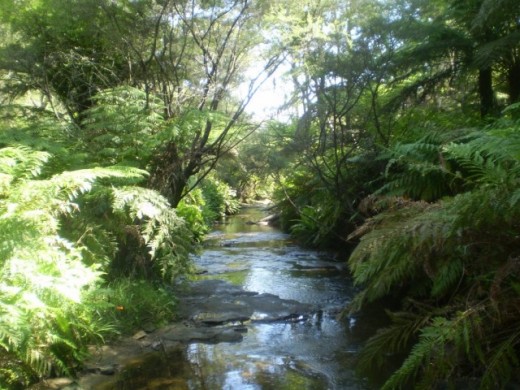 Katoomba Falls flows down the Blue Mountains escarpment into the Kedumba River Katoomba Falls flows down the Blue Mountains escarpment into the Kedumba River
.
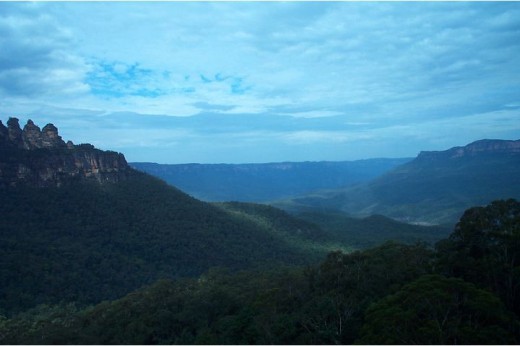 The Kedumba River flows through the Greater Blue Mountains World Heritage Area. The Kedumba River flows through the Greater Blue Mountains World Heritage Area.
|
|
 Swamp on Newnes Plateau, Blue Mountains region
Swamp on Newnes Plateau, Blue Mountains region
 Known distribution of the Endangered Blue Mountains Water Skink
Known distribution of the Endangered Blue Mountains Water Skink Longwall Mining Consequences
Total Environment Centre, ^http://www.tec.org.au/component/docman/doc_view/201-longwall-rep07
Longwall Mining Consequences
Total Environment Centre, ^http://www.tec.org.au/component/docman/doc_view/201-longwall-rep07







































































































